Mindanao State University ENG103: Deep Dive into English Phonetics
VerifiedAdded on 2023/07/11
|27
|5732
|268
Homework Assignment
AI Summary
This assignment solution for ENG103, English Phonology and Morphology, focuses on phonetics, covering its definition, the three main branches (articulatory, acoustic, and auditory phonetics), and their significance in language learning. It includes activities such as watching videos and answering questions to understand phonetics better. The solution also covers the production of consonant sounds, detailing voicing, place of articulation, and manner of articulation, along with explanations of voiced and voiceless sounds, and Voice Onset Time (VOT). Furthermore, it discusses vowels, including monophthongs and diphthongs, and states of the glottis, such as creaky voice. The material is designed to help students at Mindanao State University grasp the fundamental concepts of phonetics and morphology.
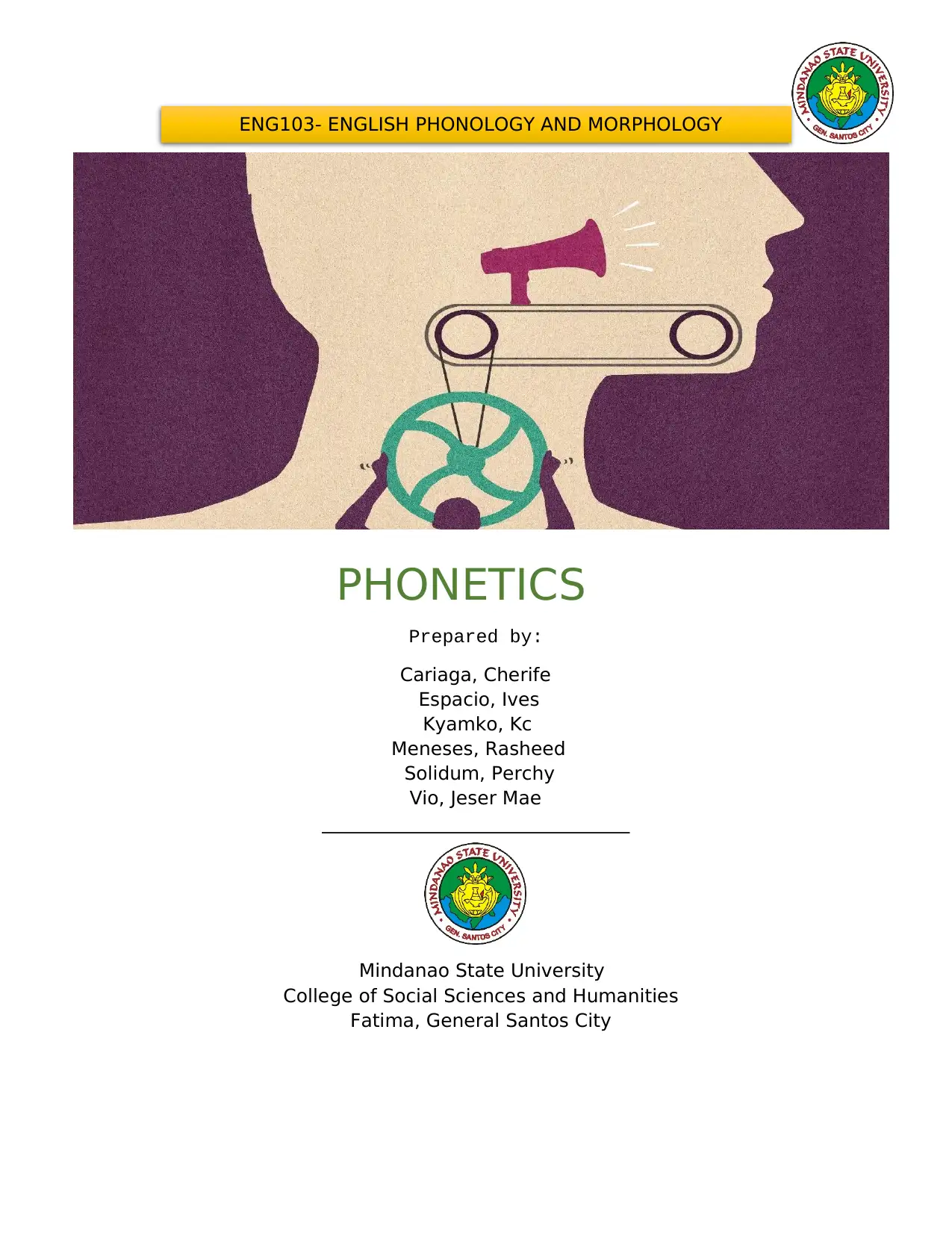
ENG103- ENGLISH PHONOLOGY AND MORPHOLOGY
PHONETICS
Prepared by:
Cariaga, Cherife
Espacio, Ives
Kyamko, Kc
Meneses, Rasheed
Solidum, Perchy
Vio, Jeser Mae
_________________________________
Mindanao State University
College of Social Sciences and Humanities
Fatima, General Santos City
PHONETICS
Prepared by:
Cariaga, Cherife
Espacio, Ives
Kyamko, Kc
Meneses, Rasheed
Solidum, Perchy
Vio, Jeser Mae
_________________________________
Mindanao State University
College of Social Sciences and Humanities
Fatima, General Santos City
Secure Best Marks with AI Grader
Need help grading? Try our AI Grader for instant feedback on your assignments.
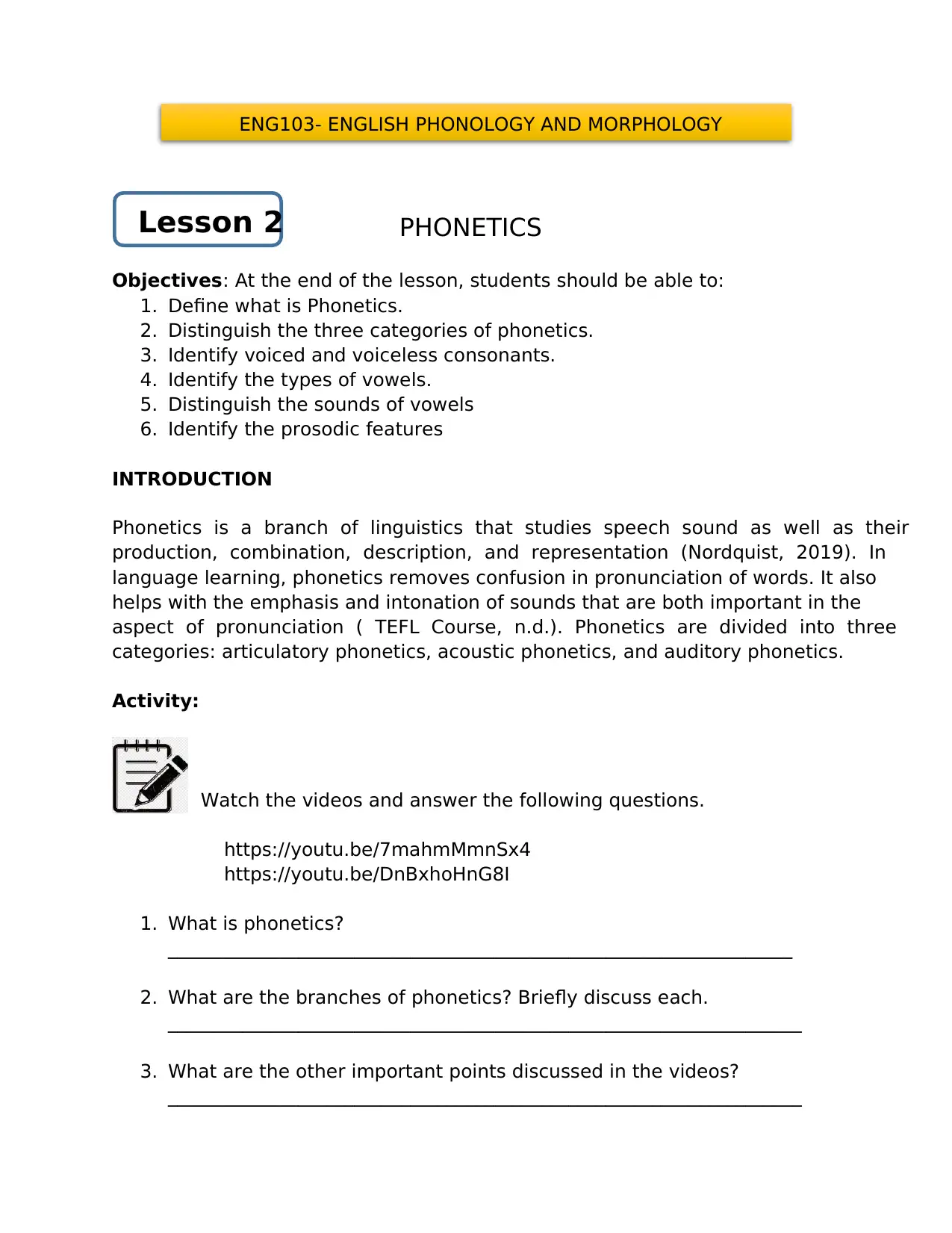
ENG103- ENGLISH PHONOLOGY AND MORPHOLOGY
PHONETICS
Objectives: At the end of the lesson, students should be able to:
1. Define what is Phonetics.
2. Distinguish the three categories of phonetics.
3. Identify voiced and voiceless consonants.
4. Identify the types of vowels.
5. Distinguish the sounds of vowels
6. Identify the prosodic features
INTRODUCTION
Phonetics is a branch of linguistics that studies speech sound as well as their
production, combination, description, and representation (Nordquist, 2019). In
language learning, phonetics removes confusion in pronunciation of words. It also
helps with the emphasis and intonation of sounds that are both important in the
aspect of pronunciation ( TEFL Course, n.d.). Phonetics are divided into three
categories: articulatory phonetics, acoustic phonetics, and auditory phonetics.
Activity:
Watch the videos and answer the following questions.
https://youtu.be/7mahmMmnSx4
https://youtu.be/DnBxhoHnG8I
1. What is phonetics?
___________________________________________________________________
2. What are the branches of phonetics? Briefly discuss each.
____________________________________________________________________
3. What are the other important points discussed in the videos?
____________________________________________________________________
Lesson 2
PHONETICS
Objectives: At the end of the lesson, students should be able to:
1. Define what is Phonetics.
2. Distinguish the three categories of phonetics.
3. Identify voiced and voiceless consonants.
4. Identify the types of vowels.
5. Distinguish the sounds of vowels
6. Identify the prosodic features
INTRODUCTION
Phonetics is a branch of linguistics that studies speech sound as well as their
production, combination, description, and representation (Nordquist, 2019). In
language learning, phonetics removes confusion in pronunciation of words. It also
helps with the emphasis and intonation of sounds that are both important in the
aspect of pronunciation ( TEFL Course, n.d.). Phonetics are divided into three
categories: articulatory phonetics, acoustic phonetics, and auditory phonetics.
Activity:
Watch the videos and answer the following questions.
https://youtu.be/7mahmMmnSx4
https://youtu.be/DnBxhoHnG8I
1. What is phonetics?
___________________________________________________________________
2. What are the branches of phonetics? Briefly discuss each.
____________________________________________________________________
3. What are the other important points discussed in the videos?
____________________________________________________________________
Lesson 2
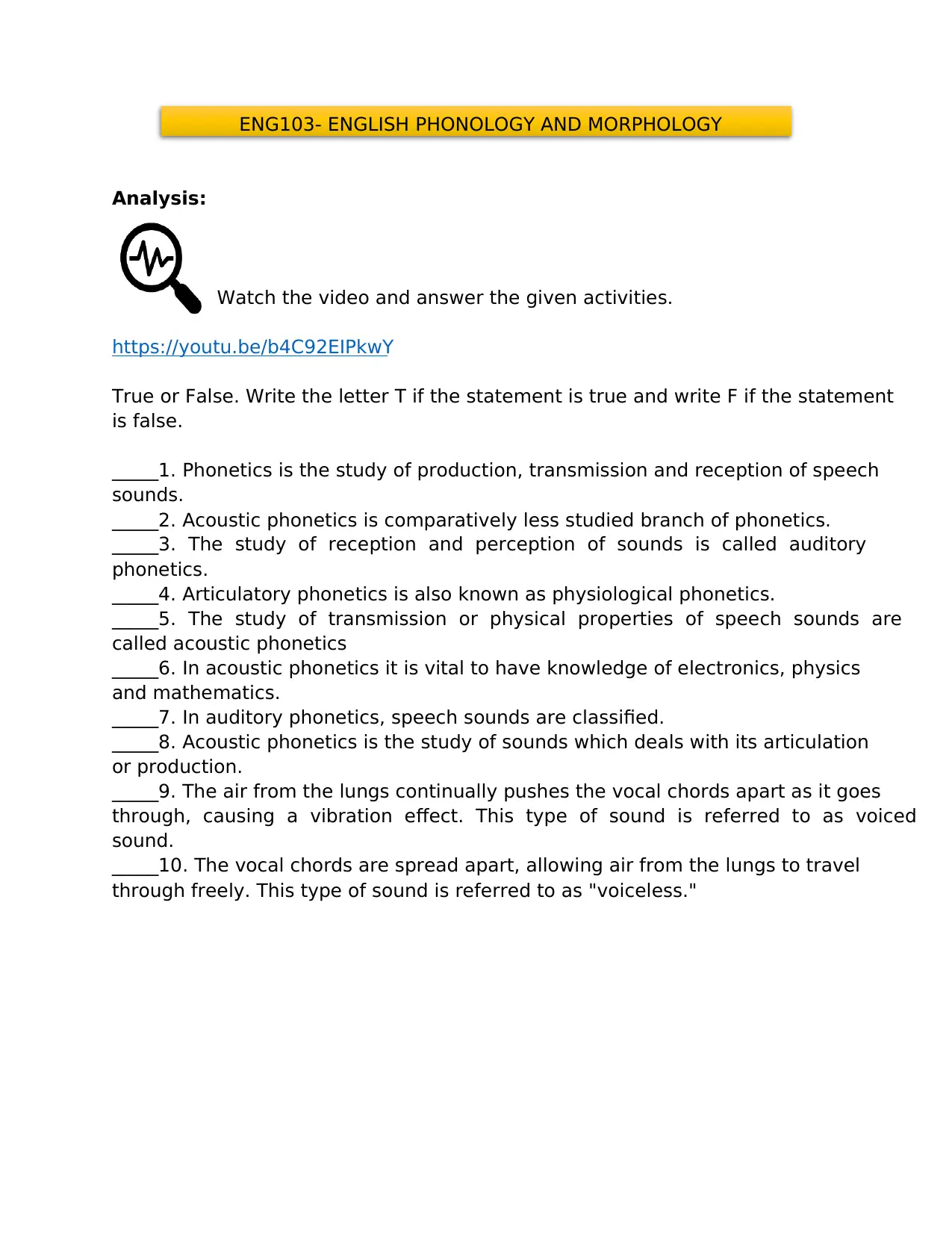
ENG103- ENGLISH PHONOLOGY AND MORPHOLOGY
Analysis:
Watch the video and answer the given activities.
https://youtu.be/b4C92EIPkwY
True or False. Write the letter T if the statement is true and write F if the statement
is false.
_____1. Phonetics is the study of production, transmission and reception of speech
sounds.
_____2. Acoustic phonetics is comparatively less studied branch of phonetics.
_____3. The study of reception and perception of sounds is called auditory
phonetics.
_____4. Articulatory phonetics is also known as physiological phonetics.
_____5. The study of transmission or physical properties of speech sounds are
called acoustic phonetics
_____6. In acoustic phonetics it is vital to have knowledge of electronics, physics
and mathematics.
_____7. In auditory phonetics, speech sounds are classified.
_____8. Acoustic phonetics is the study of sounds which deals with its articulation
or production.
_____9. The air from the lungs continually pushes the vocal chords apart as it goes
through, causing a vibration effect. This type of sound is referred to as voiced
sound.
_____10. The vocal chords are spread apart, allowing air from the lungs to travel
through freely. This type of sound is referred to as "voiceless."
Analysis:
Watch the video and answer the given activities.
https://youtu.be/b4C92EIPkwY
True or False. Write the letter T if the statement is true and write F if the statement
is false.
_____1. Phonetics is the study of production, transmission and reception of speech
sounds.
_____2. Acoustic phonetics is comparatively less studied branch of phonetics.
_____3. The study of reception and perception of sounds is called auditory
phonetics.
_____4. Articulatory phonetics is also known as physiological phonetics.
_____5. The study of transmission or physical properties of speech sounds are
called acoustic phonetics
_____6. In acoustic phonetics it is vital to have knowledge of electronics, physics
and mathematics.
_____7. In auditory phonetics, speech sounds are classified.
_____8. Acoustic phonetics is the study of sounds which deals with its articulation
or production.
_____9. The air from the lungs continually pushes the vocal chords apart as it goes
through, causing a vibration effect. This type of sound is referred to as voiced
sound.
_____10. The vocal chords are spread apart, allowing air from the lungs to travel
through freely. This type of sound is referred to as "voiceless."
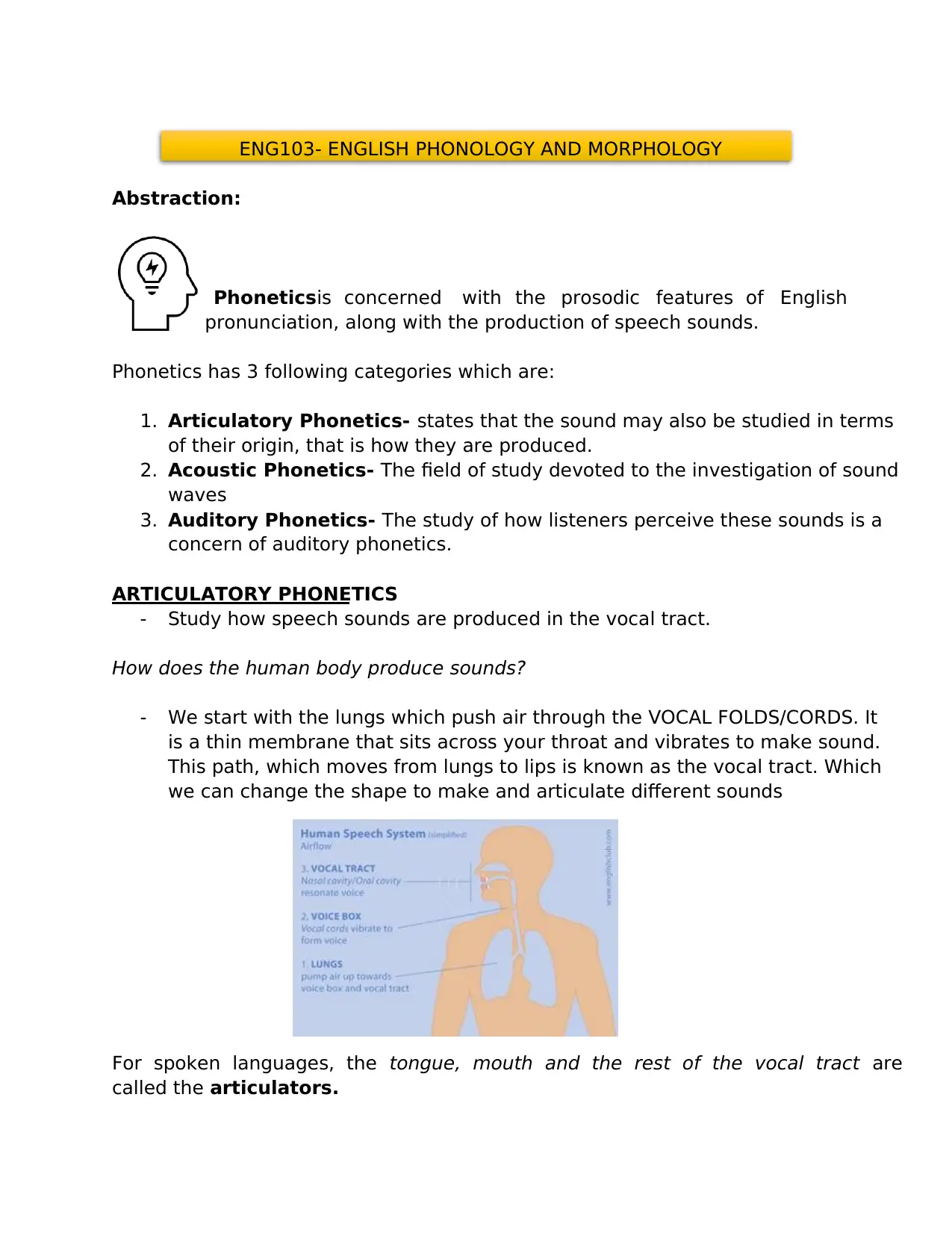
ENG103- ENGLISH PHONOLOGY AND MORPHOLOGY
Abstraction:
Phoneticsis concerned with the prosodic features of English
pronunciation, along with the production of speech sounds.
Phonetics has 3 following categories which are:
1. Articulatory Phonetics- states that the sound may also be studied in terms
of their origin, that is how they are produced.
2. Acoustic Phonetics- The field of study devoted to the investigation of sound
waves
3. Auditory Phonetics- The study of how listeners perceive these sounds is a
concern of auditory phonetics.
ARTICULATORY PHONETICS
- Study how speech sounds are produced in the vocal tract.
How does the human body produce sounds?
- We start with the lungs which push air through the VOCAL FOLDS/CORDS. It
is a thin membrane that sits across your throat and vibrates to make sound.
This path, which moves from lungs to lips is known as the vocal tract. Which
we can change the shape to make and articulate different sounds
For spoken languages, the tongue, mouth and the rest of the vocal tract are
called the articulators.
Abstraction:
Phoneticsis concerned with the prosodic features of English
pronunciation, along with the production of speech sounds.
Phonetics has 3 following categories which are:
1. Articulatory Phonetics- states that the sound may also be studied in terms
of their origin, that is how they are produced.
2. Acoustic Phonetics- The field of study devoted to the investigation of sound
waves
3. Auditory Phonetics- The study of how listeners perceive these sounds is a
concern of auditory phonetics.
ARTICULATORY PHONETICS
- Study how speech sounds are produced in the vocal tract.
How does the human body produce sounds?
- We start with the lungs which push air through the VOCAL FOLDS/CORDS. It
is a thin membrane that sits across your throat and vibrates to make sound.
This path, which moves from lungs to lips is known as the vocal tract. Which
we can change the shape to make and articulate different sounds
For spoken languages, the tongue, mouth and the rest of the vocal tract are
called the articulators.
Secure Best Marks with AI Grader
Need help grading? Try our AI Grader for instant feedback on your assignments.
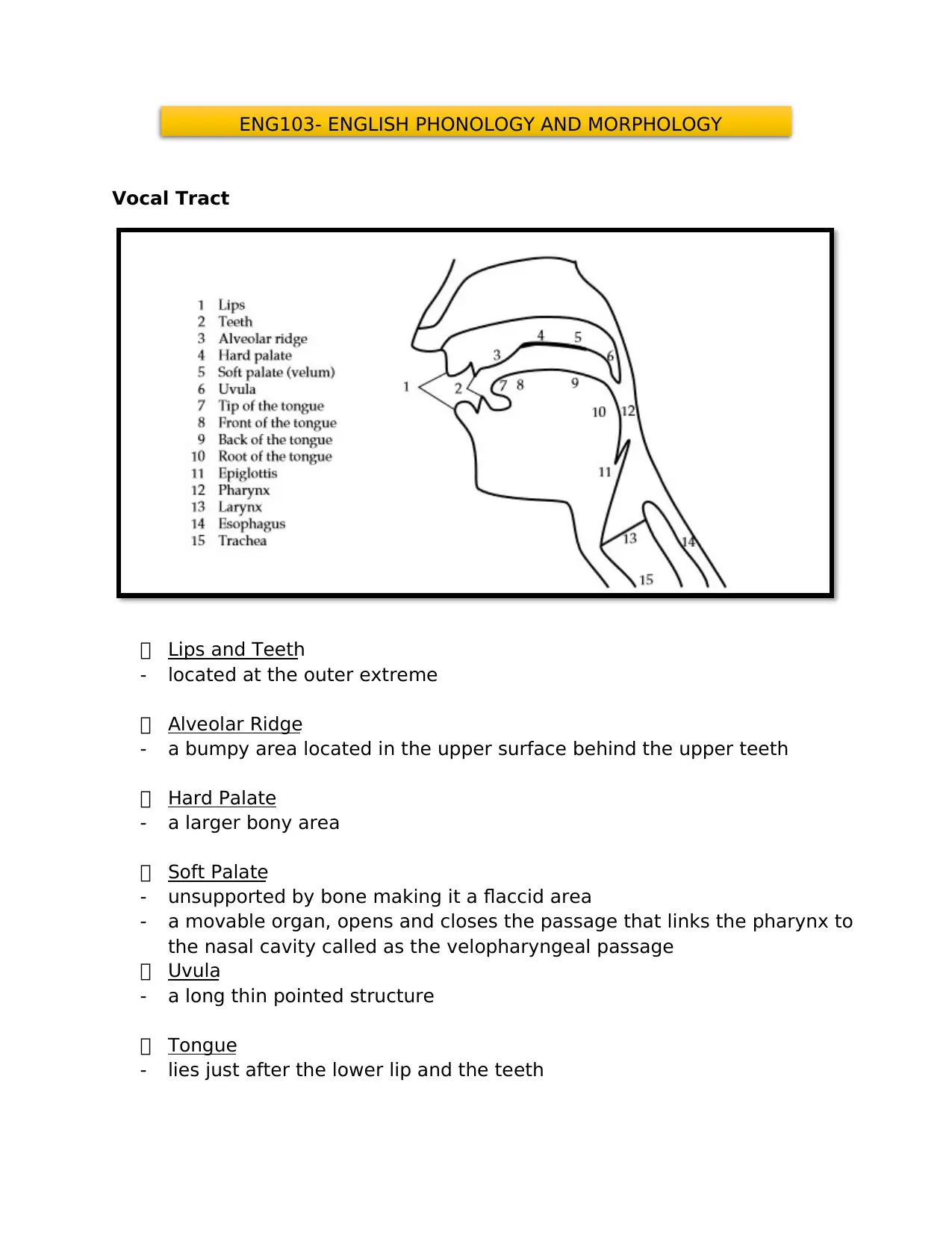
ENG103- ENGLISH PHONOLOGY AND MORPHOLOGY
Vocal Tract
Lips and Teeth
- located at the outer extreme
Alveolar Ridge
- a bumpy area located in the upper surface behind the upper teeth
Hard Palate
- a larger bony area
Soft Palate
- unsupported by bone making it a flaccid area
- a movable organ, opens and closes the passage that links the pharynx to
the nasal cavity called as the velopharyngeal passage
Uvula
- a long thin pointed structure
Tongue
- lies just after the lower lip and the teeth
Vocal Tract
Lips and Teeth
- located at the outer extreme
Alveolar Ridge
- a bumpy area located in the upper surface behind the upper teeth
Hard Palate
- a larger bony area
Soft Palate
- unsupported by bone making it a flaccid area
- a movable organ, opens and closes the passage that links the pharynx to
the nasal cavity called as the velopharyngeal passage
Uvula
- a long thin pointed structure
Tongue
- lies just after the lower lip and the teeth
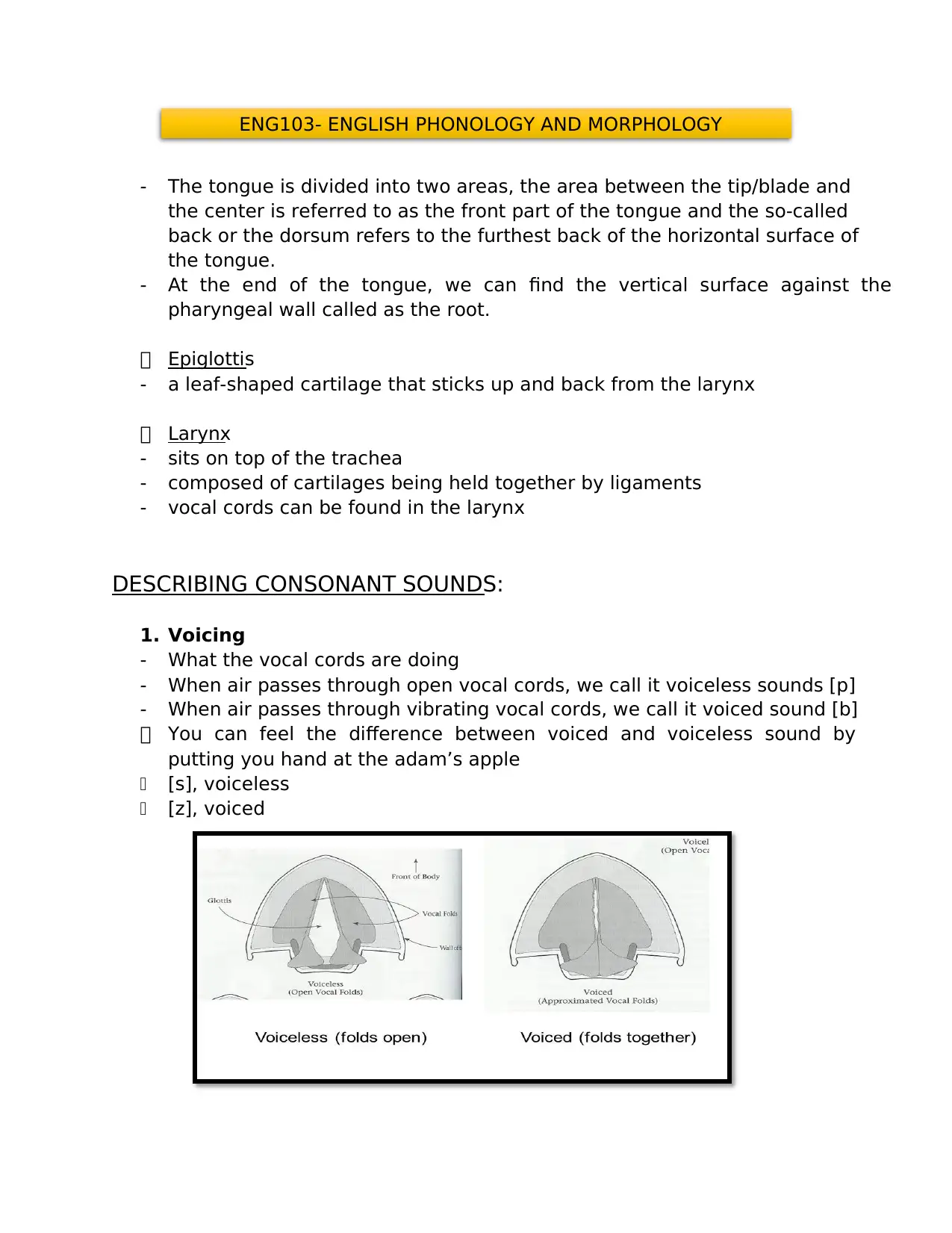
ENG103- ENGLISH PHONOLOGY AND MORPHOLOGY
- The tongue is divided into two areas, the area between the tip/blade and
the center is referred to as the front part of the tongue and the so-called
back or the dorsum refers to the furthest back of the horizontal surface of
the tongue.
- At the end of the tongue, we can find the vertical surface against the
pharyngeal wall called as the root.
Epiglottis
- a leaf-shaped cartilage that sticks up and back from the larynx
Larynx
- sits on top of the trachea
- composed of cartilages being held together by ligaments
- vocal cords can be found in the larynx
DESCRIBING CONSONANT SOUNDS:
1. Voicing
- What the vocal cords are doing
- When air passes through open vocal cords, we call it voiceless sounds [p]
- When air passes through vibrating vocal cords, we call it voiced sound [b]
You can feel the difference between voiced and voiceless sound by
putting you hand at the adam’s apple
[s], voiceless
[z], voiced
- The tongue is divided into two areas, the area between the tip/blade and
the center is referred to as the front part of the tongue and the so-called
back or the dorsum refers to the furthest back of the horizontal surface of
the tongue.
- At the end of the tongue, we can find the vertical surface against the
pharyngeal wall called as the root.
Epiglottis
- a leaf-shaped cartilage that sticks up and back from the larynx
Larynx
- sits on top of the trachea
- composed of cartilages being held together by ligaments
- vocal cords can be found in the larynx
DESCRIBING CONSONANT SOUNDS:
1. Voicing
- What the vocal cords are doing
- When air passes through open vocal cords, we call it voiceless sounds [p]
- When air passes through vibrating vocal cords, we call it voiced sound [b]
You can feel the difference between voiced and voiceless sound by
putting you hand at the adam’s apple
[s], voiceless
[z], voiced
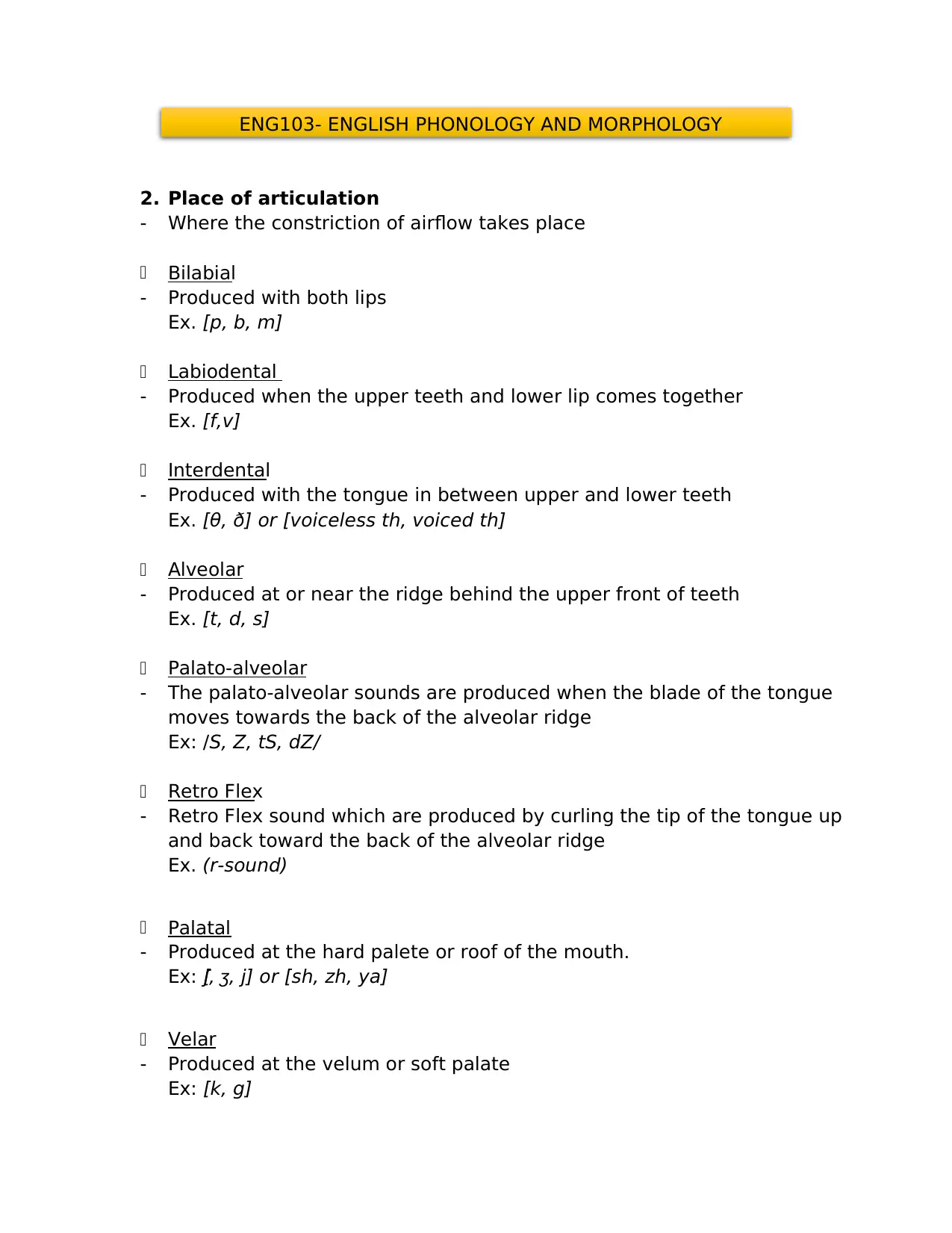
ENG103- ENGLISH PHONOLOGY AND MORPHOLOGY
2. Place of articulation
- Where the constriction of airflow takes place
Bilabial
- Produced with both lips
Ex. [p, b, m]
Labiodental
- Produced when the upper teeth and lower lip comes together
Ex. [f,v]
Interdental
- Produced with the tongue in between upper and lower teeth
Ex. [θ, ð] or [voiceless th, voiced th]
Alveolar
- Produced at or near the ridge behind the upper front of teeth
Ex. [t, d, s]
Palato-alveolar
- The palato-alveolar sounds are produced when the blade of the tongue
moves towards the back of the alveolar ridge
Ex: /S, Z, tS, dZ/
Retro Flex
- Retro Flex sound which are produced by curling the tip of the tongue up
and back toward the back of the alveolar ridge
Ex. (r-sound)
Palatal
- Produced at the hard palete or roof of the mouth.
Ex: [ʃ, ʒ, j] or [sh, zh, ya]
Velar
- Produced at the velum or soft palate
Ex: [k, g]
2. Place of articulation
- Where the constriction of airflow takes place
Bilabial
- Produced with both lips
Ex. [p, b, m]
Labiodental
- Produced when the upper teeth and lower lip comes together
Ex. [f,v]
Interdental
- Produced with the tongue in between upper and lower teeth
Ex. [θ, ð] or [voiceless th, voiced th]
Alveolar
- Produced at or near the ridge behind the upper front of teeth
Ex. [t, d, s]
Palato-alveolar
- The palato-alveolar sounds are produced when the blade of the tongue
moves towards the back of the alveolar ridge
Ex: /S, Z, tS, dZ/
Retro Flex
- Retro Flex sound which are produced by curling the tip of the tongue up
and back toward the back of the alveolar ridge
Ex. (r-sound)
Palatal
- Produced at the hard palete or roof of the mouth.
Ex: [ʃ, ʒ, j] or [sh, zh, ya]
Velar
- Produced at the velum or soft palate
Ex: [k, g]
Paraphrase This Document
Need a fresh take? Get an instant paraphrase of this document with our AI Paraphraser
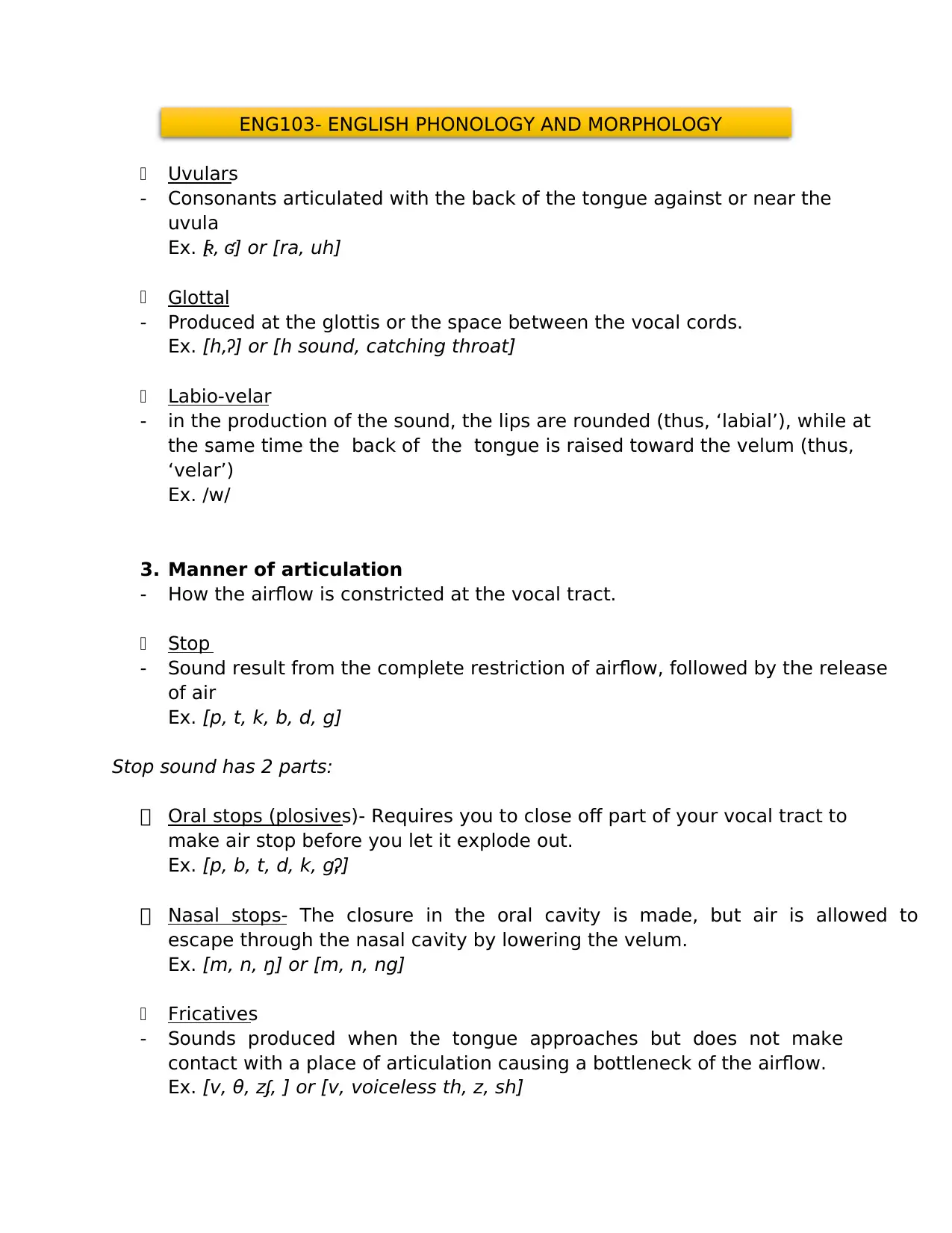
ENG103- ENGLISH PHONOLOGY AND MORPHOLOGY
Uvulars
- Consonants articulated with the back of the tongue against or near the
uvula
Ex. [ʀ, ʛ] or [ra, uh]
Glottal
- Produced at the glottis or the space between the vocal cords.
Ex. [h,ʔ] or [h sound, catching throat]
Labio-velar
- in the production of the sound, the lips are rounded (thus, ‘labial’), while at
the same time the back of the tongue is raised toward the velum (thus,
‘velar’)
Ex. /w/
3. Manner of articulation
- How the airflow is constricted at the vocal tract.
Stop
- Sound result from the complete restriction of airflow, followed by the release
of air
Ex. [p, t, k, b, d, g]
Stop sound has 2 parts:
Oral stops (plosives)- Requires you to close off part of your vocal tract to
make air stop before you let it explode out.
Ex. [p, b, t, d, k, g,ʔ]
Nasal stops- The closure in the oral cavity is made, but air is allowed to
escape through the nasal cavity by lowering the velum.
Ex. [m, n, ŋ] or [m, n, ng]
Fricatives
- Sounds produced when the tongue approaches but does not make
contact with a place of articulation causing a bottleneck of the airflow.
Ex. [v, θ, z,ʃ, ] or [v, voiceless th, z, sh]
Uvulars
- Consonants articulated with the back of the tongue against or near the
uvula
Ex. [ʀ, ʛ] or [ra, uh]
Glottal
- Produced at the glottis or the space between the vocal cords.
Ex. [h,ʔ] or [h sound, catching throat]
Labio-velar
- in the production of the sound, the lips are rounded (thus, ‘labial’), while at
the same time the back of the tongue is raised toward the velum (thus,
‘velar’)
Ex. /w/
3. Manner of articulation
- How the airflow is constricted at the vocal tract.
Stop
- Sound result from the complete restriction of airflow, followed by the release
of air
Ex. [p, t, k, b, d, g]
Stop sound has 2 parts:
Oral stops (plosives)- Requires you to close off part of your vocal tract to
make air stop before you let it explode out.
Ex. [p, b, t, d, k, g,ʔ]
Nasal stops- The closure in the oral cavity is made, but air is allowed to
escape through the nasal cavity by lowering the velum.
Ex. [m, n, ŋ] or [m, n, ng]
Fricatives
- Sounds produced when the tongue approaches but does not make
contact with a place of articulation causing a bottleneck of the airflow.
Ex. [v, θ, z,ʃ, ] or [v, voiceless th, z, sh]
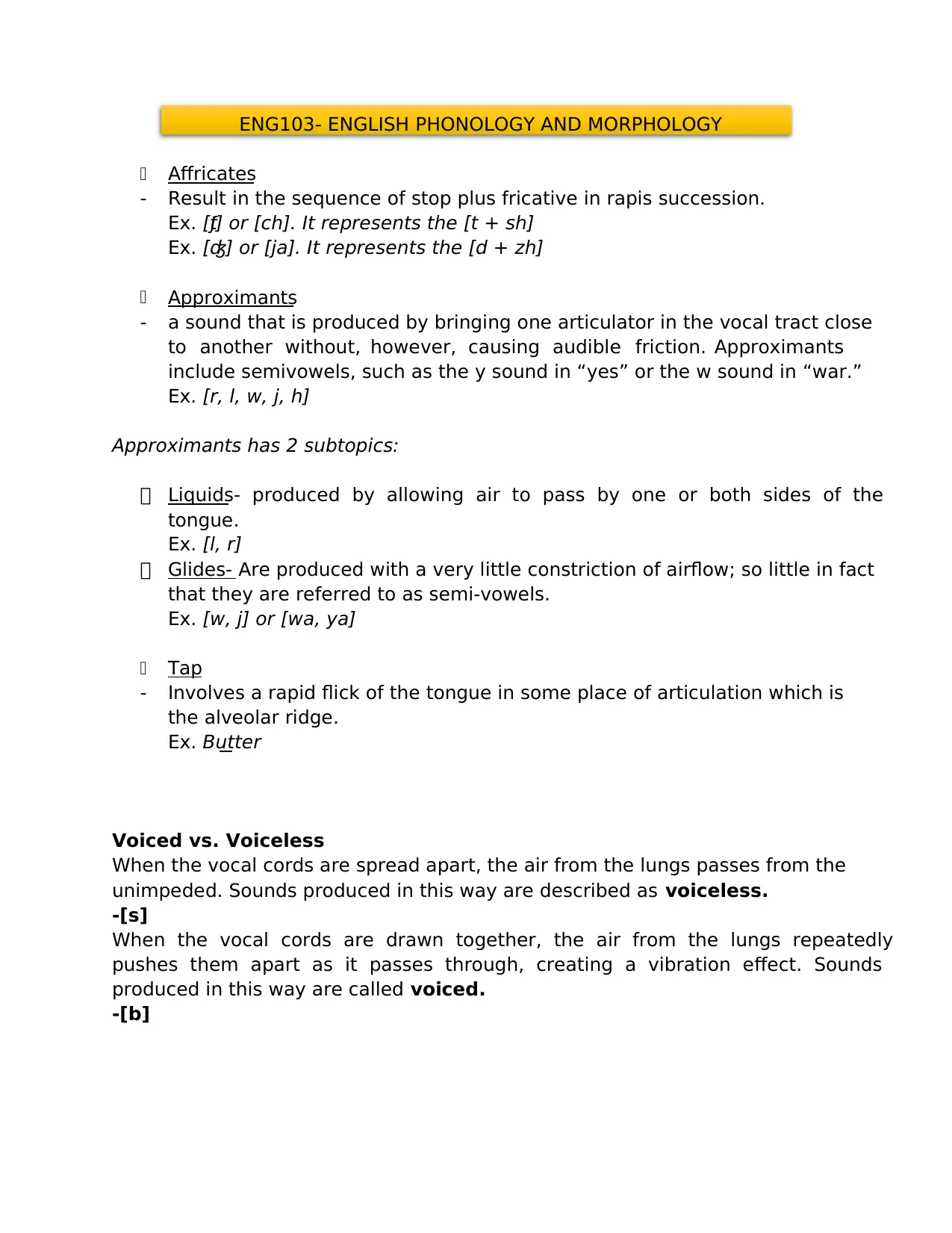
ENG103- ENGLISH PHONOLOGY AND MORPHOLOGY
Affricates
- Result in the sequence of stop plus fricative in rapis succession.
Ex. [tʃ] or [ch]. It represents the [t + sh]
Ex. [dʒ] or [ja]. It represents the [d + zh]
Approximants
- a sound that is produced by bringing one articulator in the vocal tract close
to another without, however, causing audible friction. Approximants
include semivowels, such as the y sound in “yes” or the w sound in “war.”
Ex. [r, l, w, j, h]
Approximants has 2 subtopics:
Liquids- produced by allowing air to pass by one or both sides of the
tongue.
Ex. [l, r]
Glides- Are produced with a very little constriction of airflow; so little in fact
that they are referred to as semi-vowels.
Ex. [w, j] or [wa, ya]
Tap
- Involves a rapid flick of the tongue in some place of articulation which is
the alveolar ridge.
Ex. Butter
Voiced vs. Voiceless
When the vocal cords are spread apart, the air from the lungs passes from the
unimpeded. Sounds produced in this way are described as voiceless.
-[s]
When the vocal cords are drawn together, the air from the lungs repeatedly
pushes them apart as it passes through, creating a vibration effect. Sounds
produced in this way are called voiced.
-[b]
Affricates
- Result in the sequence of stop plus fricative in rapis succession.
Ex. [tʃ] or [ch]. It represents the [t + sh]
Ex. [dʒ] or [ja]. It represents the [d + zh]
Approximants
- a sound that is produced by bringing one articulator in the vocal tract close
to another without, however, causing audible friction. Approximants
include semivowels, such as the y sound in “yes” or the w sound in “war.”
Ex. [r, l, w, j, h]
Approximants has 2 subtopics:
Liquids- produced by allowing air to pass by one or both sides of the
tongue.
Ex. [l, r]
Glides- Are produced with a very little constriction of airflow; so little in fact
that they are referred to as semi-vowels.
Ex. [w, j] or [wa, ya]
Tap
- Involves a rapid flick of the tongue in some place of articulation which is
the alveolar ridge.
Ex. Butter
Voiced vs. Voiceless
When the vocal cords are spread apart, the air from the lungs passes from the
unimpeded. Sounds produced in this way are described as voiceless.
-[s]
When the vocal cords are drawn together, the air from the lungs repeatedly
pushes them apart as it passes through, creating a vibration effect. Sounds
produced in this way are called voiced.
-[b]
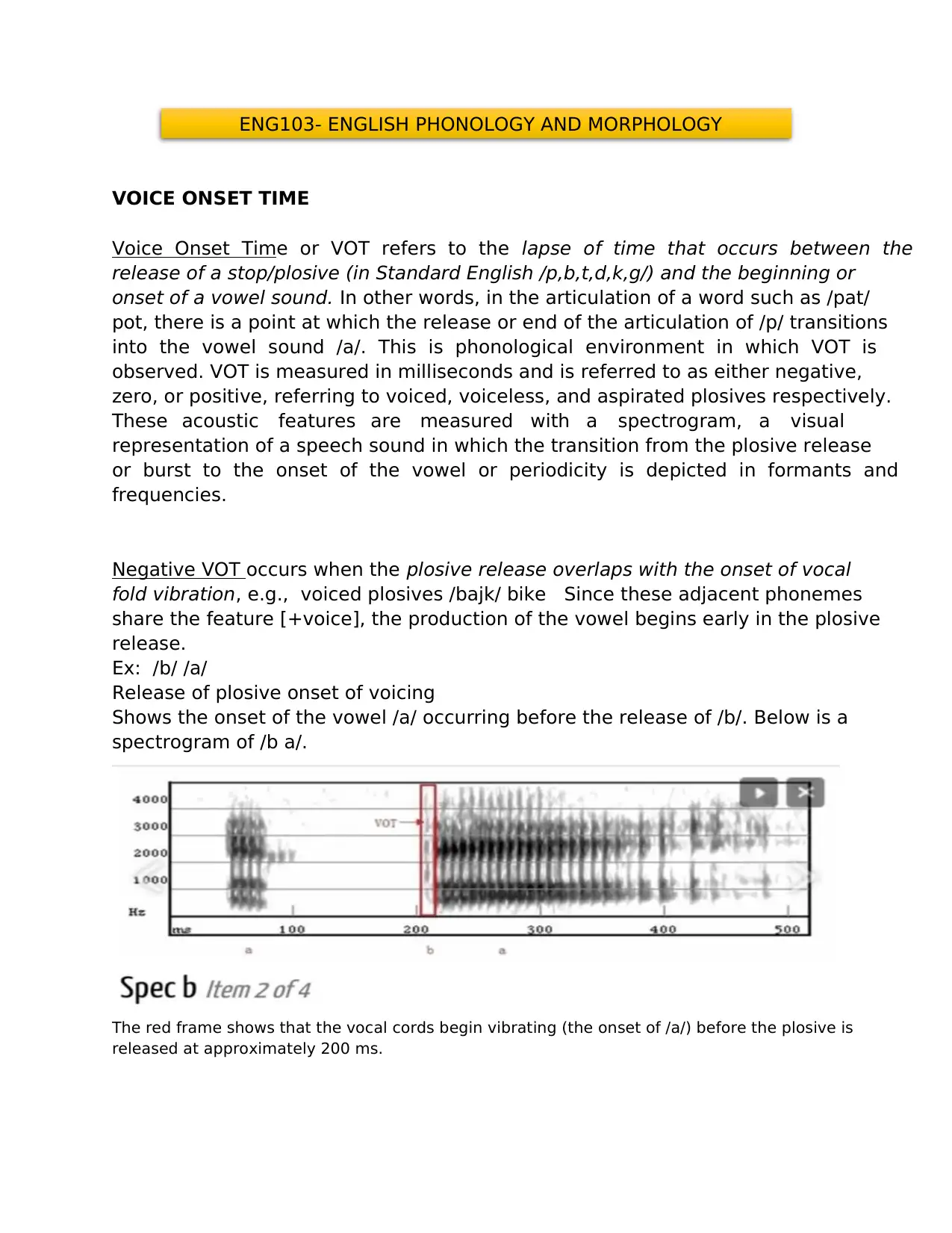
ENG103- ENGLISH PHONOLOGY AND MORPHOLOGY
VOICE ONSET TIME
Voice Onset Time or VOT refers to the lapse of time that occurs between the
release of a stop/plosive (in Standard English /p,b,t,d,k,g/) and the beginning or
onset of a vowel sound. In other words, in the articulation of a word such as /pat/
pot, there is a point at which the release or end of the articulation of /p/ transitions
into the vowel sound /a/. This is phonological environment in which VOT is
observed. VOT is measured in milliseconds and is referred to as either negative,
zero, or positive, referring to voiced, voiceless, and aspirated plosives respectively.
These acoustic features are measured with a spectrogram, a visual
representation of a speech sound in which the transition from the plosive release
or burst to the onset of the vowel or periodicity is depicted in formants and
frequencies.
Negative VOT occurs when the plosive release overlaps with the onset of vocal
fold vibration, e.g., voiced plosives /bajk/ bike Since these adjacent phonemes
share the feature [+voice], the production of the vowel begins early in the plosive
release.
Ex: /b/ /a/
Release of plosive onset of voicing
Shows the onset of the vowel /a/ occurring before the release of /b/. Below is a
spectrogram of /b a/.
The red frame shows that the vocal cords begin vibrating (the onset of /a/) before the plosive is
released at approximately 200 ms.
VOICE ONSET TIME
Voice Onset Time or VOT refers to the lapse of time that occurs between the
release of a stop/plosive (in Standard English /p,b,t,d,k,g/) and the beginning or
onset of a vowel sound. In other words, in the articulation of a word such as /pat/
pot, there is a point at which the release or end of the articulation of /p/ transitions
into the vowel sound /a/. This is phonological environment in which VOT is
observed. VOT is measured in milliseconds and is referred to as either negative,
zero, or positive, referring to voiced, voiceless, and aspirated plosives respectively.
These acoustic features are measured with a spectrogram, a visual
representation of a speech sound in which the transition from the plosive release
or burst to the onset of the vowel or periodicity is depicted in formants and
frequencies.
Negative VOT occurs when the plosive release overlaps with the onset of vocal
fold vibration, e.g., voiced plosives /bajk/ bike Since these adjacent phonemes
share the feature [+voice], the production of the vowel begins early in the plosive
release.
Ex: /b/ /a/
Release of plosive onset of voicing
Shows the onset of the vowel /a/ occurring before the release of /b/. Below is a
spectrogram of /b a/.
The red frame shows that the vocal cords begin vibrating (the onset of /a/) before the plosive is
released at approximately 200 ms.
Secure Best Marks with AI Grader
Need help grading? Try our AI Grader for instant feedback on your assignments.
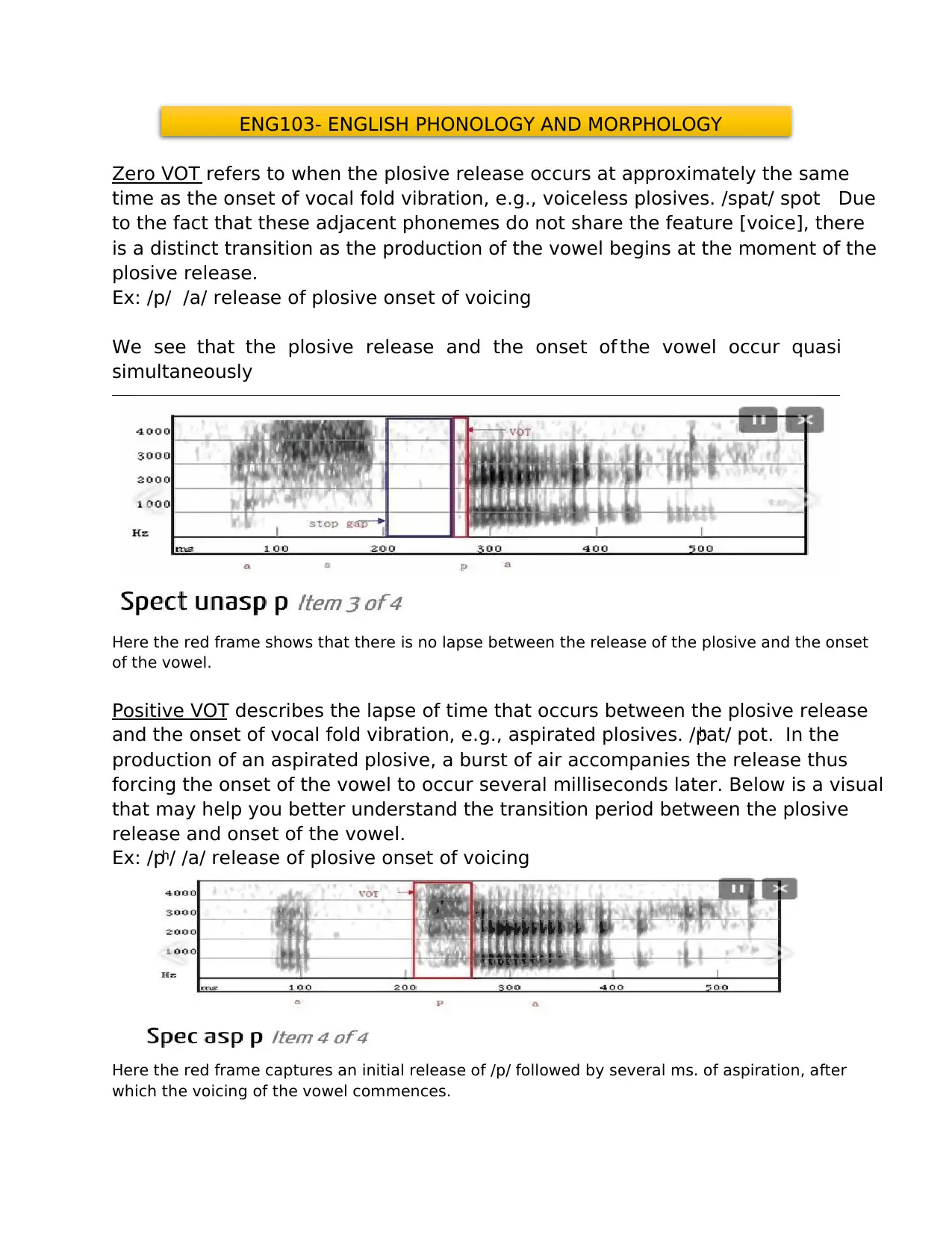
ENG103- ENGLISH PHONOLOGY AND MORPHOLOGY
Zero VOT refers to when the plosive release occurs at approximately the same
time as the onset of vocal fold vibration, e.g., voiceless plosives. /spat/ spot Due
to the fact that these adjacent phonemes do not share the feature [voice], there
is a distinct transition as the production of the vowel begins at the moment of the
plosive release.
Ex: /p/ /a/ release of plosive onset of voicing
We see that the plosive release and the onset of the vowel occur quasi
simultaneously
Here the red frame shows that there is no lapse between the release of the plosive and the onset
of the vowel.
Positive VOT describes the lapse of time that occurs between the plosive release
and the onset of vocal fold vibration, e.g., aspirated plosives. /pʰat/ pot. In the
production of an aspirated plosive, a burst of air accompanies the release thus
forcing the onset of the vowel to occur several milliseconds later. Below is a visual
that may help you better understand the transition period between the plosive
release and onset of the vowel.
Ex: /pʰ/ /a/ release of plosive onset of voicing
Here the red frame captures an initial release of /p/ followed by several ms. of aspiration, after
which the voicing of the vowel commences.
Zero VOT refers to when the plosive release occurs at approximately the same
time as the onset of vocal fold vibration, e.g., voiceless plosives. /spat/ spot Due
to the fact that these adjacent phonemes do not share the feature [voice], there
is a distinct transition as the production of the vowel begins at the moment of the
plosive release.
Ex: /p/ /a/ release of plosive onset of voicing
We see that the plosive release and the onset of the vowel occur quasi
simultaneously
Here the red frame shows that there is no lapse between the release of the plosive and the onset
of the vowel.
Positive VOT describes the lapse of time that occurs between the plosive release
and the onset of vocal fold vibration, e.g., aspirated plosives. /pʰat/ pot. In the
production of an aspirated plosive, a burst of air accompanies the release thus
forcing the onset of the vowel to occur several milliseconds later. Below is a visual
that may help you better understand the transition period between the plosive
release and onset of the vowel.
Ex: /pʰ/ /a/ release of plosive onset of voicing
Here the red frame captures an initial release of /p/ followed by several ms. of aspiration, after
which the voicing of the vowel commences.
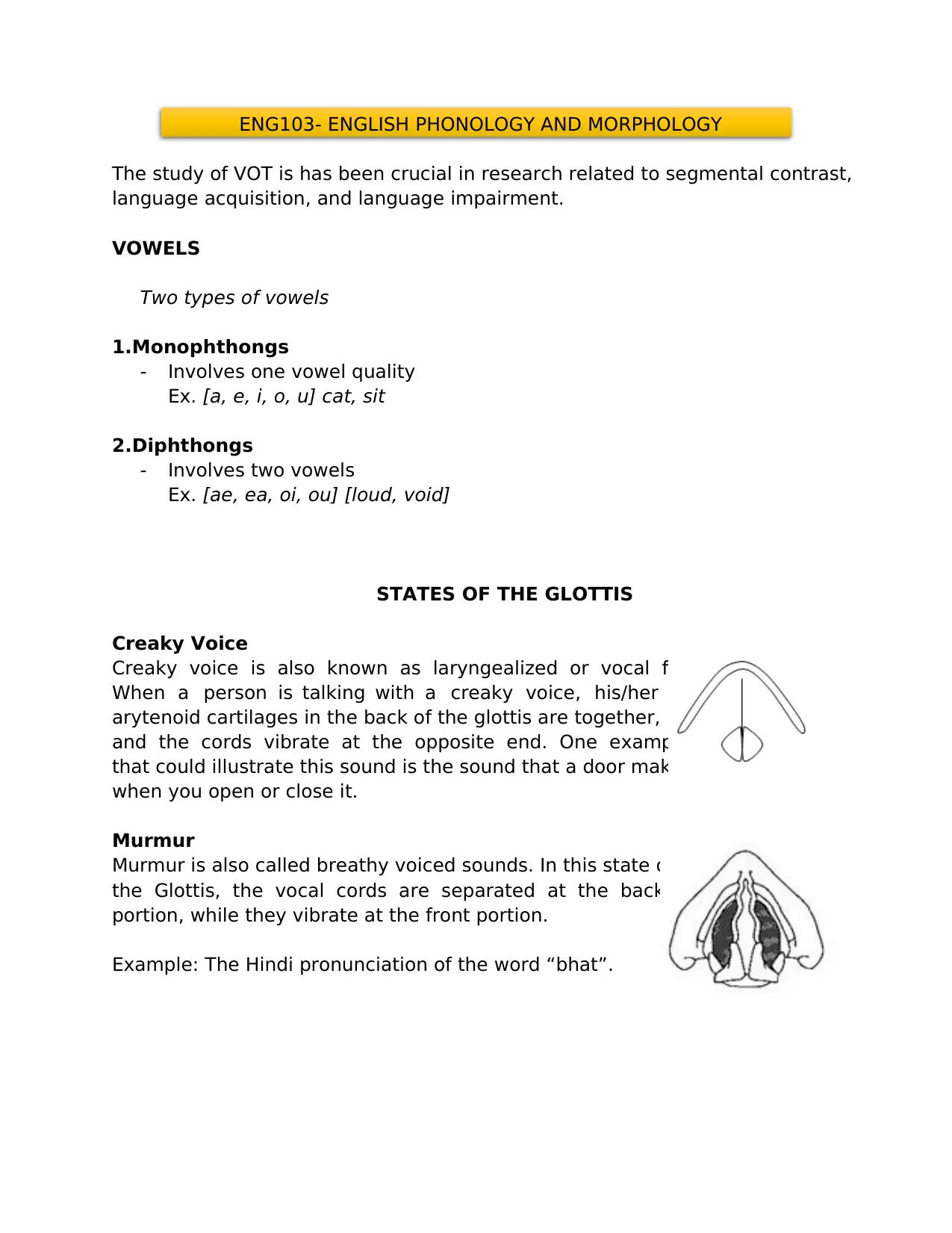
ENG103- ENGLISH PHONOLOGY AND MORPHOLOGY
The study of VOT is has been crucial in research related to segmental contrast,
language acquisition, and language impairment.
VOWELS
Two types of vowels
1.Monophthongs
- Involves one vowel quality
Ex. [a, e, i, o, u] cat, sit
2.Diphthongs
- Involves two vowels
Ex. [ae, ea, oi, ou] [loud, void]
STATES OF THE GLOTTIS
Creaky Voice
Creaky voice is also known as laryngealized or vocal fry.
When a person is talking with a creaky voice, his/her
arytenoid cartilages in the back of the glottis are together,
and the cords vibrate at the opposite end. One example
that could illustrate this sound is the sound that a door makes
when you open or close it.
Murmur
Murmur is also called breathy voiced sounds. In this state of
the Glottis, the vocal cords are separated at the back
portion, while they vibrate at the front portion.
Example: The Hindi pronunciation of the word “bhat”.
The study of VOT is has been crucial in research related to segmental contrast,
language acquisition, and language impairment.
VOWELS
Two types of vowels
1.Monophthongs
- Involves one vowel quality
Ex. [a, e, i, o, u] cat, sit
2.Diphthongs
- Involves two vowels
Ex. [ae, ea, oi, ou] [loud, void]
STATES OF THE GLOTTIS
Creaky Voice
Creaky voice is also known as laryngealized or vocal fry.
When a person is talking with a creaky voice, his/her
arytenoid cartilages in the back of the glottis are together,
and the cords vibrate at the opposite end. One example
that could illustrate this sound is the sound that a door makes
when you open or close it.
Murmur
Murmur is also called breathy voiced sounds. In this state of
the Glottis, the vocal cords are separated at the back
portion, while they vibrate at the front portion.
Example: The Hindi pronunciation of the word “bhat”.
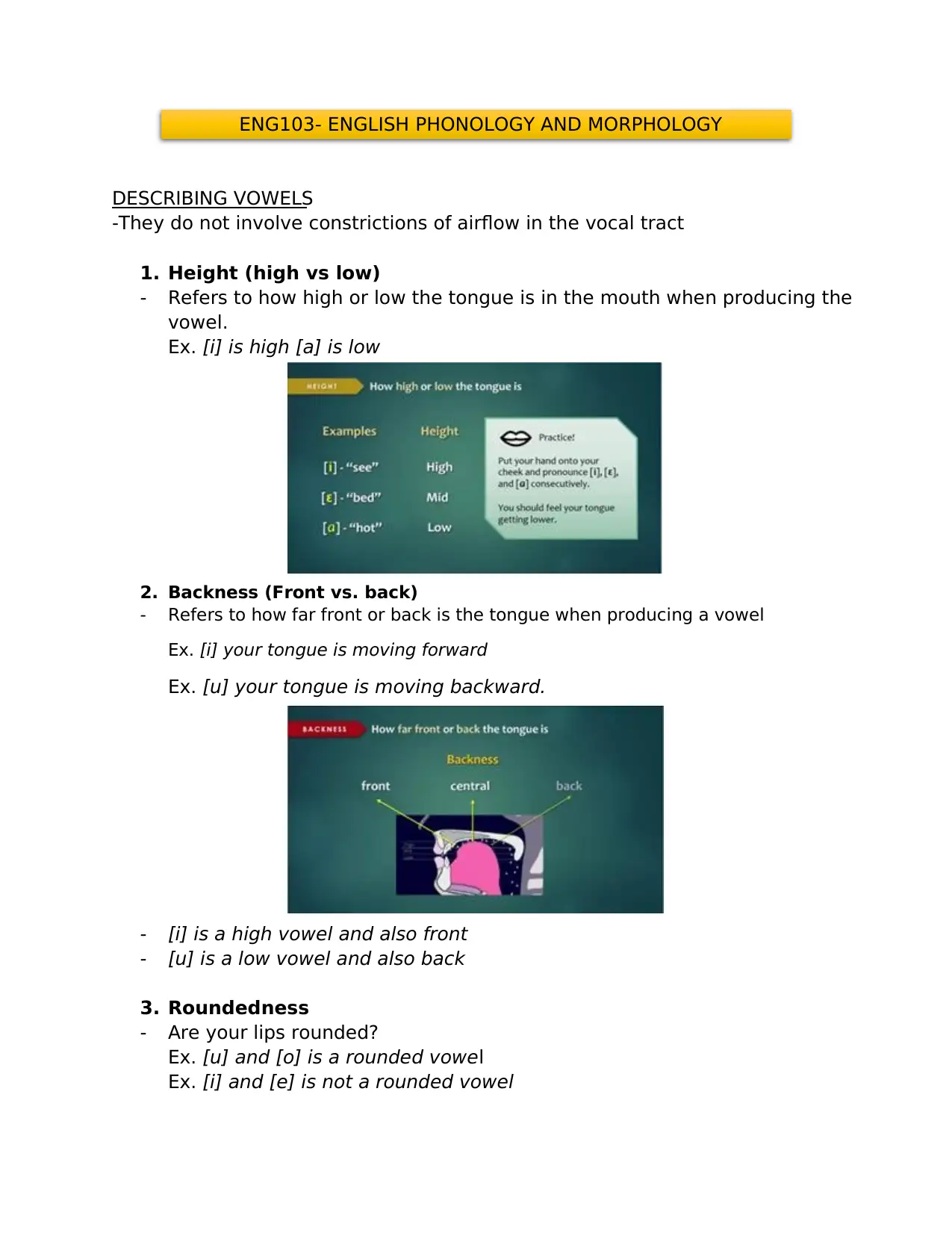
ENG103- ENGLISH PHONOLOGY AND MORPHOLOGY
DESCRIBING VOWELS
-They do not involve constrictions of airflow in the vocal tract
1. Height (high vs low)
- Refers to how high or low the tongue is in the mouth when producing the
vowel.
Ex. [i] is high [a] is low
2. Backness (Front vs. back)
- Refers to how far front or back is the tongue when producing a vowel
Ex. [i] your tongue is moving forward
Ex. [u] your tongue is moving backward.
- [i] is a high vowel and also front
- [u] is a low vowel and also back
3. Roundedness
- Are your lips rounded?
Ex. [u] and [o] is a rounded vowel
Ex. [i] and [e] is not a rounded vowel
DESCRIBING VOWELS
-They do not involve constrictions of airflow in the vocal tract
1. Height (high vs low)
- Refers to how high or low the tongue is in the mouth when producing the
vowel.
Ex. [i] is high [a] is low
2. Backness (Front vs. back)
- Refers to how far front or back is the tongue when producing a vowel
Ex. [i] your tongue is moving forward
Ex. [u] your tongue is moving backward.
- [i] is a high vowel and also front
- [u] is a low vowel and also back
3. Roundedness
- Are your lips rounded?
Ex. [u] and [o] is a rounded vowel
Ex. [i] and [e] is not a rounded vowel
Paraphrase This Document
Need a fresh take? Get an instant paraphrase of this document with our AI Paraphraser
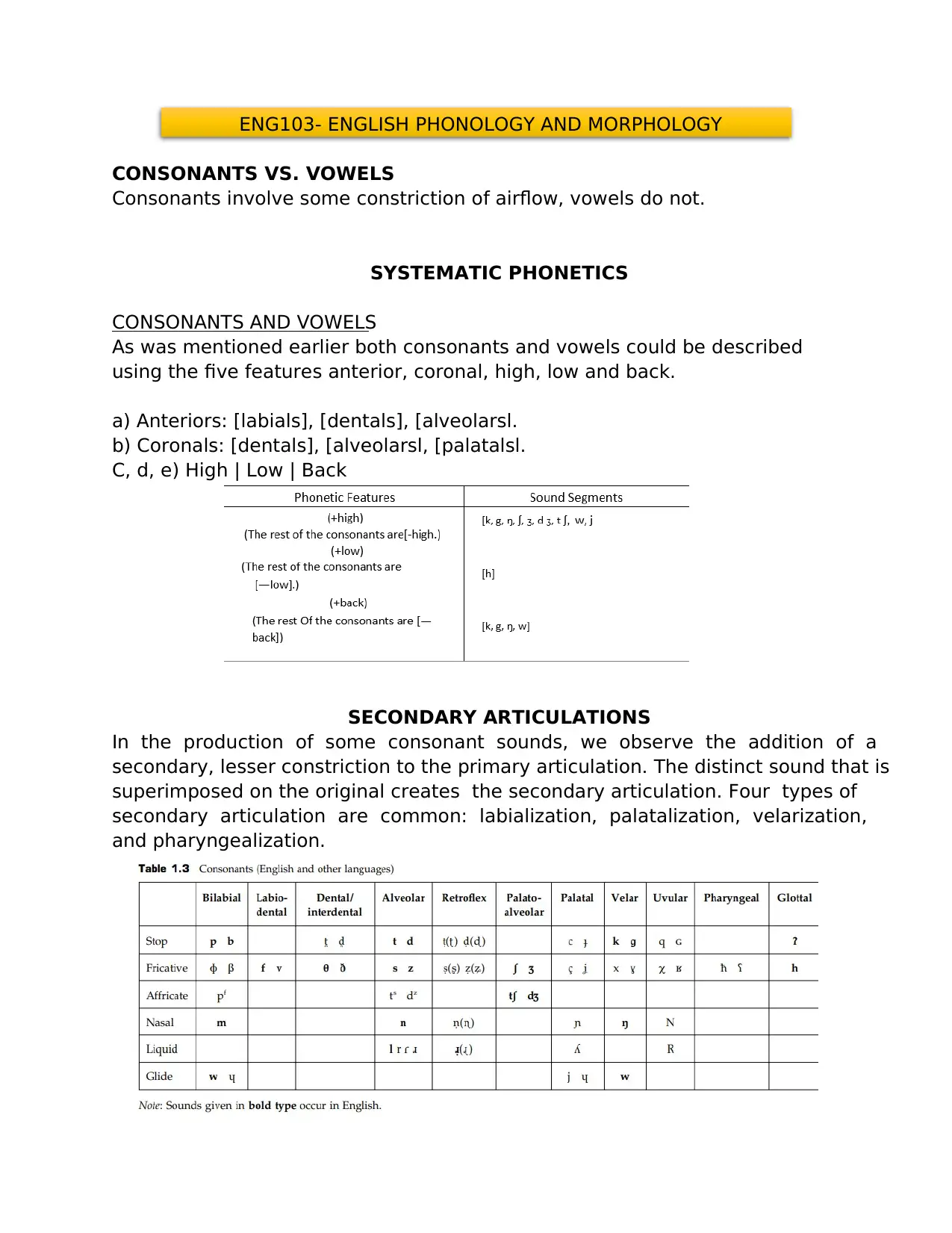
ENG103- ENGLISH PHONOLOGY AND MORPHOLOGY
CONSONANTS VS. VOWELS
Consonants involve some constriction of airflow, vowels do not.
SYSTEMATIC PHONETICS
CONSONANTS AND VOWELS
As was mentioned earlier both consonants and vowels could be described
using the five features anterior, coronal, high, low and back.
a) Anteriors: [labials], [dentals], [alveolarsl.
b) Coronals: [dentals], [alveolarsl, [palatalsl.
C, d, e) High | Low | Back
SECONDARY ARTICULATIONS
In the production of some consonant sounds, we observe the addition of a
secondary, lesser constriction to the primary articulation. The distinct sound that is
superimposed on the original creates the secondary articulation. Four types of
secondary articulation are common: labialization, palatalization, velarization,
and pharyngealization.
CONSONANTS VS. VOWELS
Consonants involve some constriction of airflow, vowels do not.
SYSTEMATIC PHONETICS
CONSONANTS AND VOWELS
As was mentioned earlier both consonants and vowels could be described
using the five features anterior, coronal, high, low and back.
a) Anteriors: [labials], [dentals], [alveolarsl.
b) Coronals: [dentals], [alveolarsl, [palatalsl.
C, d, e) High | Low | Back
SECONDARY ARTICULATIONS
In the production of some consonant sounds, we observe the addition of a
secondary, lesser constriction to the primary articulation. The distinct sound that is
superimposed on the original creates the secondary articulation. Four types of
secondary articulation are common: labialization, palatalization, velarization,
and pharyngealization.
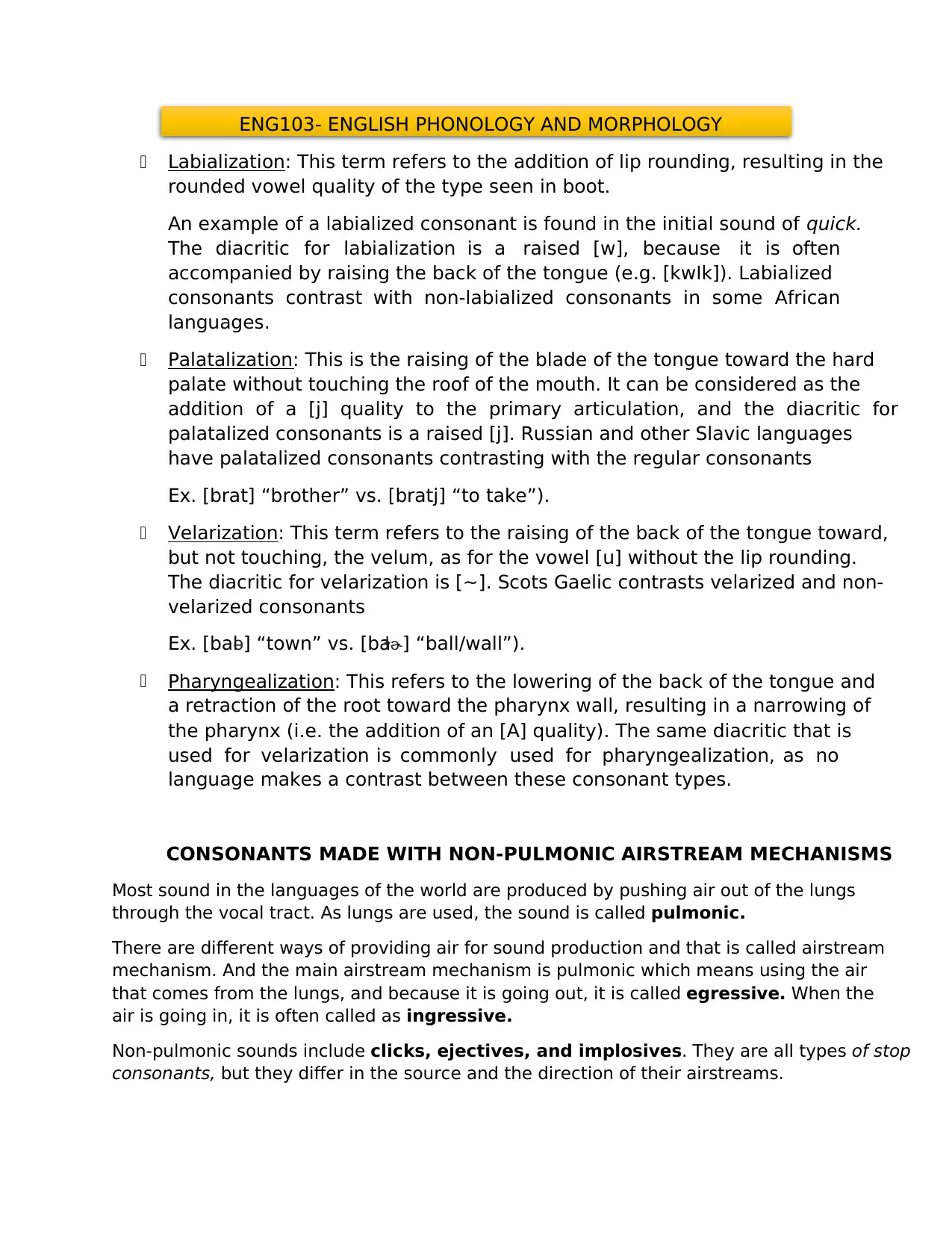
ENG103- ENGLISH PHONOLOGY AND MORPHOLOGY
Labialization: This term refers to the addition of lip rounding, resulting in the
rounded vowel quality of the type seen in boot.
An example of a labialized consonant is found in the initial sound of quick.
The diacritic for labialization is a raised [w], because it is often
accompanied by raising the back of the tongue (e.g. [kwIk]). Labialized
consonants contrast with non-labialized consonants in some African
languages.
Palatalization: This is the raising of the blade of the tongue toward the hard
palate without touching the roof of the mouth. It can be considered as the
addition of a [j] quality to the primary articulation, and the diacritic for
palatalized consonants is a raised [j]. Russian and other Slavic languages
have palatalized consonants contrasting with the regular consonants
Ex. [brat] “brother” vs. [bratj] “to take”).
Velarization: This term refers to the raising of the back of the tongue toward,
but not touching, the velum, as for the vowel [u] without the lip rounding.
The diacritic for velarization is [~]. Scots Gaelic contrasts velarized and non-
velarized consonants
Ex. [balə] “town” vs. [baɫɚ] “ball/wall”).
Pharyngealization: This refers to the lowering of the back of the tongue and
a retraction of the root toward the pharynx wall, resulting in a narrowing of
the pharynx (i.e. the addition of an [A] quality). The same diacritic that is
used for velarization is commonly used for pharyngealization, as no
language makes a contrast between these consonant types.
CONSONANTS MADE WITH NON-PULMONIC AIRSTREAM MECHANISMS
Most sound in the languages of the world are produced by pushing air out of the lungs
through the vocal tract. As lungs are used, the sound is called pulmonic.
There are different ways of providing air for sound production and that is called airstream
mechanism. And the main airstream mechanism is pulmonic which means using the air
that comes from the lungs, and because it is going out, it is called egressive. When the
air is going in, it is often called as ingressive.
Non-pulmonic sounds include clicks, ejectives, and implosives. They are all types of stop
consonants, but they differ in the source and the direction of their airstreams.
Labialization: This term refers to the addition of lip rounding, resulting in the
rounded vowel quality of the type seen in boot.
An example of a labialized consonant is found in the initial sound of quick.
The diacritic for labialization is a raised [w], because it is often
accompanied by raising the back of the tongue (e.g. [kwIk]). Labialized
consonants contrast with non-labialized consonants in some African
languages.
Palatalization: This is the raising of the blade of the tongue toward the hard
palate without touching the roof of the mouth. It can be considered as the
addition of a [j] quality to the primary articulation, and the diacritic for
palatalized consonants is a raised [j]. Russian and other Slavic languages
have palatalized consonants contrasting with the regular consonants
Ex. [brat] “brother” vs. [bratj] “to take”).
Velarization: This term refers to the raising of the back of the tongue toward,
but not touching, the velum, as for the vowel [u] without the lip rounding.
The diacritic for velarization is [~]. Scots Gaelic contrasts velarized and non-
velarized consonants
Ex. [balə] “town” vs. [baɫɚ] “ball/wall”).
Pharyngealization: This refers to the lowering of the back of the tongue and
a retraction of the root toward the pharynx wall, resulting in a narrowing of
the pharynx (i.e. the addition of an [A] quality). The same diacritic that is
used for velarization is commonly used for pharyngealization, as no
language makes a contrast between these consonant types.
CONSONANTS MADE WITH NON-PULMONIC AIRSTREAM MECHANISMS
Most sound in the languages of the world are produced by pushing air out of the lungs
through the vocal tract. As lungs are used, the sound is called pulmonic.
There are different ways of providing air for sound production and that is called airstream
mechanism. And the main airstream mechanism is pulmonic which means using the air
that comes from the lungs, and because it is going out, it is called egressive. When the
air is going in, it is often called as ingressive.
Non-pulmonic sounds include clicks, ejectives, and implosives. They are all types of stop
consonants, but they differ in the source and the direction of their airstreams.
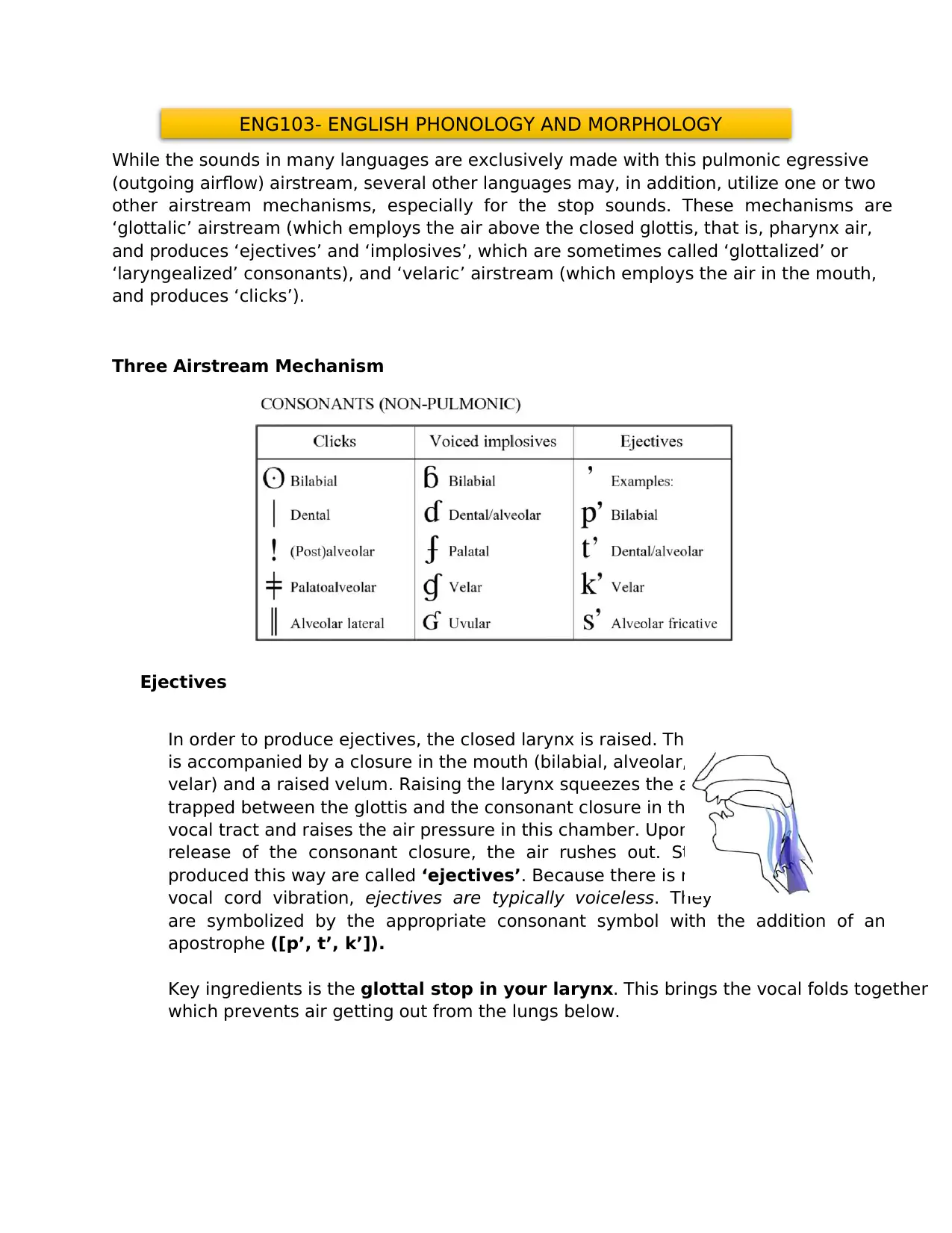
ENG103- ENGLISH PHONOLOGY AND MORPHOLOGY
While the sounds in many languages are exclusively made with this pulmonic egressive
(outgoing airflow) airstream, several other languages may, in addition, utilize one or two
other airstream mechanisms, especially for the stop sounds. These mechanisms are
‘glottalic’ airstream (which employs the air above the closed glottis, that is, pharynx air,
and produces ‘ejectives’ and ‘implosives’, which are sometimes called ‘glottalized’ or
‘laryngealized’ consonants), and ‘velaric’ airstream (which employs the air in the mouth,
and produces ‘clicks’).
Three Airstream Mechanism
Ejectives
In order to produce ejectives, the closed larynx is raised. This
is accompanied by a closure in the mouth (bilabial, alveolar,
velar) and a raised velum. Raising the larynx squeezes the air
trapped between the glottis and the consonant closure in the
vocal tract and raises the air pressure in this chamber. Upon
release of the consonant closure, the air rushes out. Stops
produced this way are called ‘ejectives’. Because there is no
vocal cord vibration, ejectives are typically voiceless. They
are symbolized by the appropriate consonant symbol with the addition of an
apostrophe ([p’, t’, k’]).
Key ingredients is the glottal stop in your larynx. This brings the vocal folds together
which prevents air getting out from the lungs below.
While the sounds in many languages are exclusively made with this pulmonic egressive
(outgoing airflow) airstream, several other languages may, in addition, utilize one or two
other airstream mechanisms, especially for the stop sounds. These mechanisms are
‘glottalic’ airstream (which employs the air above the closed glottis, that is, pharynx air,
and produces ‘ejectives’ and ‘implosives’, which are sometimes called ‘glottalized’ or
‘laryngealized’ consonants), and ‘velaric’ airstream (which employs the air in the mouth,
and produces ‘clicks’).
Three Airstream Mechanism
Ejectives
In order to produce ejectives, the closed larynx is raised. This
is accompanied by a closure in the mouth (bilabial, alveolar,
velar) and a raised velum. Raising the larynx squeezes the air
trapped between the glottis and the consonant closure in the
vocal tract and raises the air pressure in this chamber. Upon
release of the consonant closure, the air rushes out. Stops
produced this way are called ‘ejectives’. Because there is no
vocal cord vibration, ejectives are typically voiceless. They
are symbolized by the appropriate consonant symbol with the addition of an
apostrophe ([p’, t’, k’]).
Key ingredients is the glottal stop in your larynx. This brings the vocal folds together
which prevents air getting out from the lungs below.
Secure Best Marks with AI Grader
Need help grading? Try our AI Grader for instant feedback on your assignments.
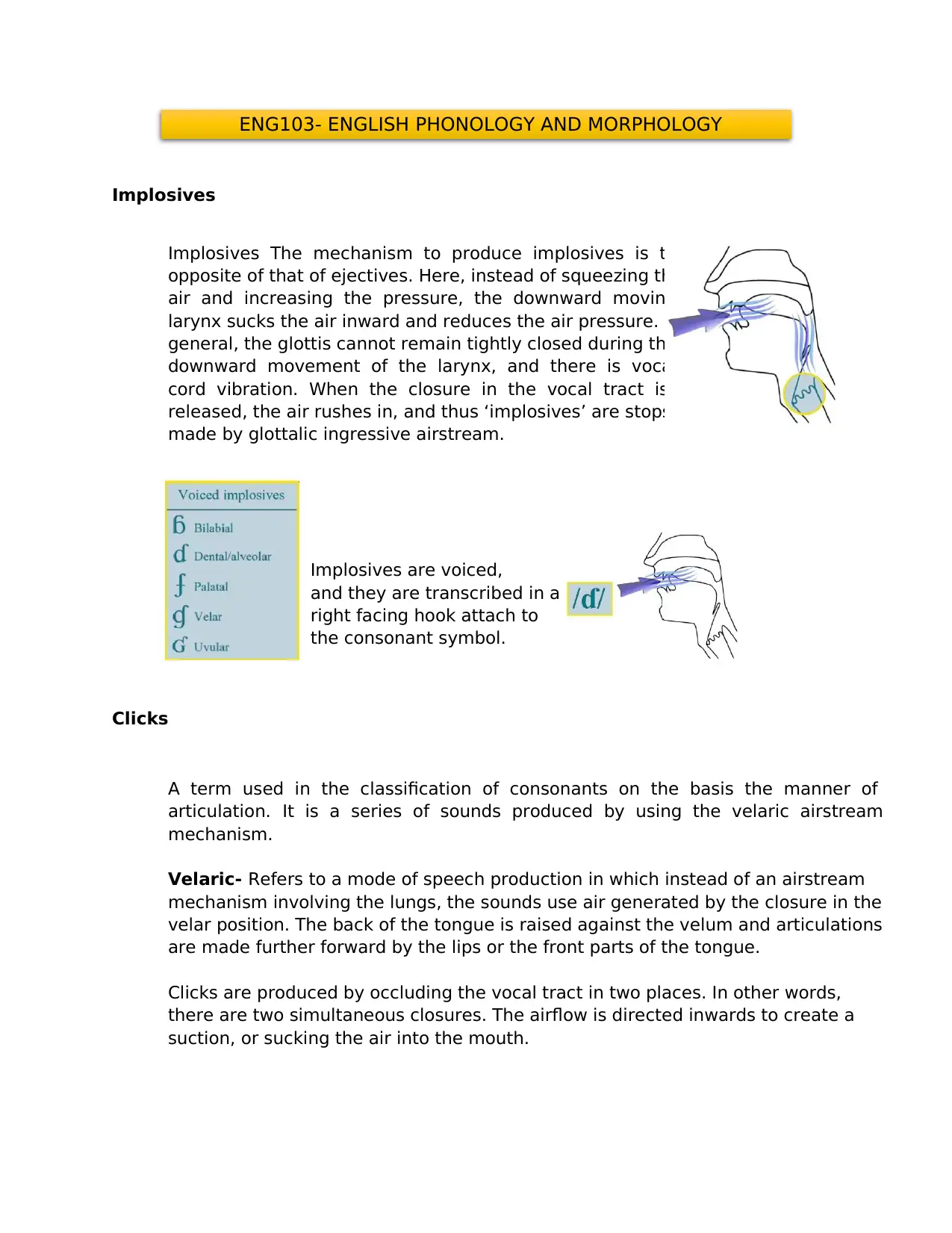
ENG103- ENGLISH PHONOLOGY AND MORPHOLOGY
Implosives
Implosives The mechanism to produce implosives is the
opposite of that of ejectives. Here, instead of squeezing the
air and increasing the pressure, the downward moving
larynx sucks the air inward and reduces the air pressure. In
general, the glottis cannot remain tightly closed during this
downward movement of the larynx, and there is vocal
cord vibration. When the closure in the vocal tract is
released, the air rushes in, and thus ‘implosives’ are stops
made by glottalic ingressive airstream.
Implosives are voiced,
and they are transcribed in a
right facing hook attach to
the consonant symbol.
Clicks
A term used in the classification of consonants on the basis the manner of
articulation. It is a series of sounds produced by using the velaric airstream
mechanism.
Velaric- Refers to a mode of speech production in which instead of an airstream
mechanism involving the lungs, the sounds use air generated by the closure in the
velar position. The back of the tongue is raised against the velum and articulations
are made further forward by the lips or the front parts of the tongue.
Clicks are produced by occluding the vocal tract in two places. In other words,
there are two simultaneous closures. The airflow is directed inwards to create a
suction, or sucking the air into the mouth.
Implosives
Implosives The mechanism to produce implosives is the
opposite of that of ejectives. Here, instead of squeezing the
air and increasing the pressure, the downward moving
larynx sucks the air inward and reduces the air pressure. In
general, the glottis cannot remain tightly closed during this
downward movement of the larynx, and there is vocal
cord vibration. When the closure in the vocal tract is
released, the air rushes in, and thus ‘implosives’ are stops
made by glottalic ingressive airstream.
Implosives are voiced,
and they are transcribed in a
right facing hook attach to
the consonant symbol.
Clicks
A term used in the classification of consonants on the basis the manner of
articulation. It is a series of sounds produced by using the velaric airstream
mechanism.
Velaric- Refers to a mode of speech production in which instead of an airstream
mechanism involving the lungs, the sounds use air generated by the closure in the
velar position. The back of the tongue is raised against the velum and articulations
are made further forward by the lips or the front parts of the tongue.
Clicks are produced by occluding the vocal tract in two places. In other words,
there are two simultaneous closures. The airflow is directed inwards to create a
suction, or sucking the air into the mouth.
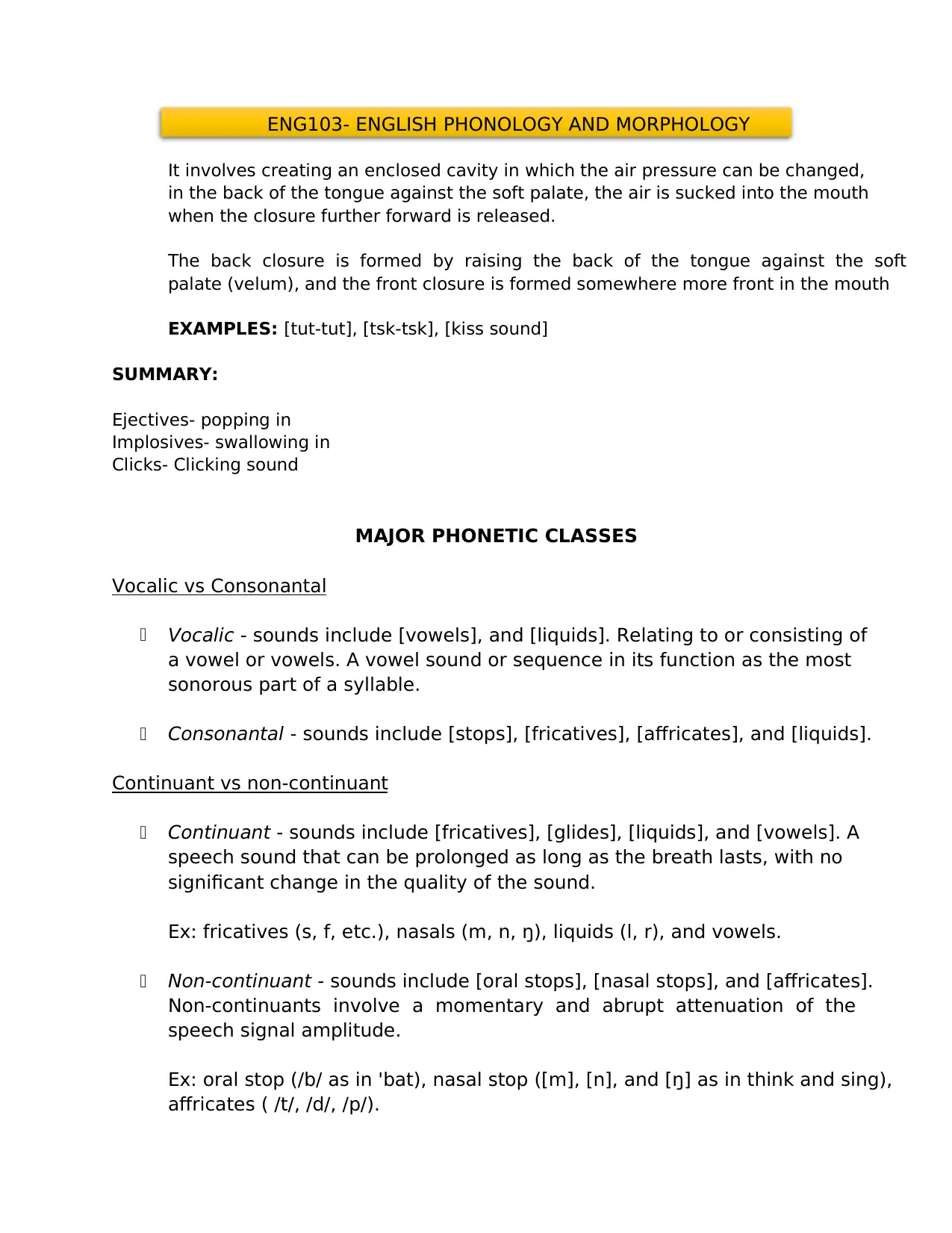
ENG103- ENGLISH PHONOLOGY AND MORPHOLOGY
It involves creating an enclosed cavity in which the air pressure can be changed,
in the back of the tongue against the soft palate, the air is sucked into the mouth
when the closure further forward is released.
The back closure is formed by raising the back of the tongue against the soft
palate (velum), and the front closure is formed somewhere more front in the mouth
EXAMPLES: [tut-tut], [tsk-tsk], [kiss sound]
SUMMARY:
Ejectives- popping in
Implosives- swallowing in
Clicks- Clicking sound
MAJOR PHONETIC CLASSES
Vocalic vs Consonantal
Vocalic - sounds include [vowels], and [liquids]. Relating to or consisting of
a vowel or vowels. A vowel sound or sequence in its function as the most
sonorous part of a syllable.
Consonantal - sounds include [stops], [fricatives], [affricates], and [liquids].
Continuant vs non-continuant
Continuant - sounds include [fricatives], [glides], [liquids], and [vowels]. A
speech sound that can be prolonged as long as the breath lasts, with no
significant change in the quality of the sound.
Ex: fricatives (s, f, etc.), nasals (m, n, ŋ), liquids (l, r), and vowels.
Non-continuant - sounds include [oral stops], [nasal stops], and [affricates].
Non-continuants involve a momentary and abrupt attenuation of the
speech signal amplitude.
Ex: oral stop (/b/ as in 'bat), nasal stop ([m], [n], and [ŋ] as in think and sing),
affricates ( /t/, /d/, /p/).
It involves creating an enclosed cavity in which the air pressure can be changed,
in the back of the tongue against the soft palate, the air is sucked into the mouth
when the closure further forward is released.
The back closure is formed by raising the back of the tongue against the soft
palate (velum), and the front closure is formed somewhere more front in the mouth
EXAMPLES: [tut-tut], [tsk-tsk], [kiss sound]
SUMMARY:
Ejectives- popping in
Implosives- swallowing in
Clicks- Clicking sound
MAJOR PHONETIC CLASSES
Vocalic vs Consonantal
Vocalic - sounds include [vowels], and [liquids]. Relating to or consisting of
a vowel or vowels. A vowel sound or sequence in its function as the most
sonorous part of a syllable.
Consonantal - sounds include [stops], [fricatives], [affricates], and [liquids].
Continuant vs non-continuant
Continuant - sounds include [fricatives], [glides], [liquids], and [vowels]. A
speech sound that can be prolonged as long as the breath lasts, with no
significant change in the quality of the sound.
Ex: fricatives (s, f, etc.), nasals (m, n, ŋ), liquids (l, r), and vowels.
Non-continuant - sounds include [oral stops], [nasal stops], and [affricates].
Non-continuants involve a momentary and abrupt attenuation of the
speech signal amplitude.
Ex: oral stop (/b/ as in 'bat), nasal stop ([m], [n], and [ŋ] as in think and sing),
affricates ( /t/, /d/, /p/).
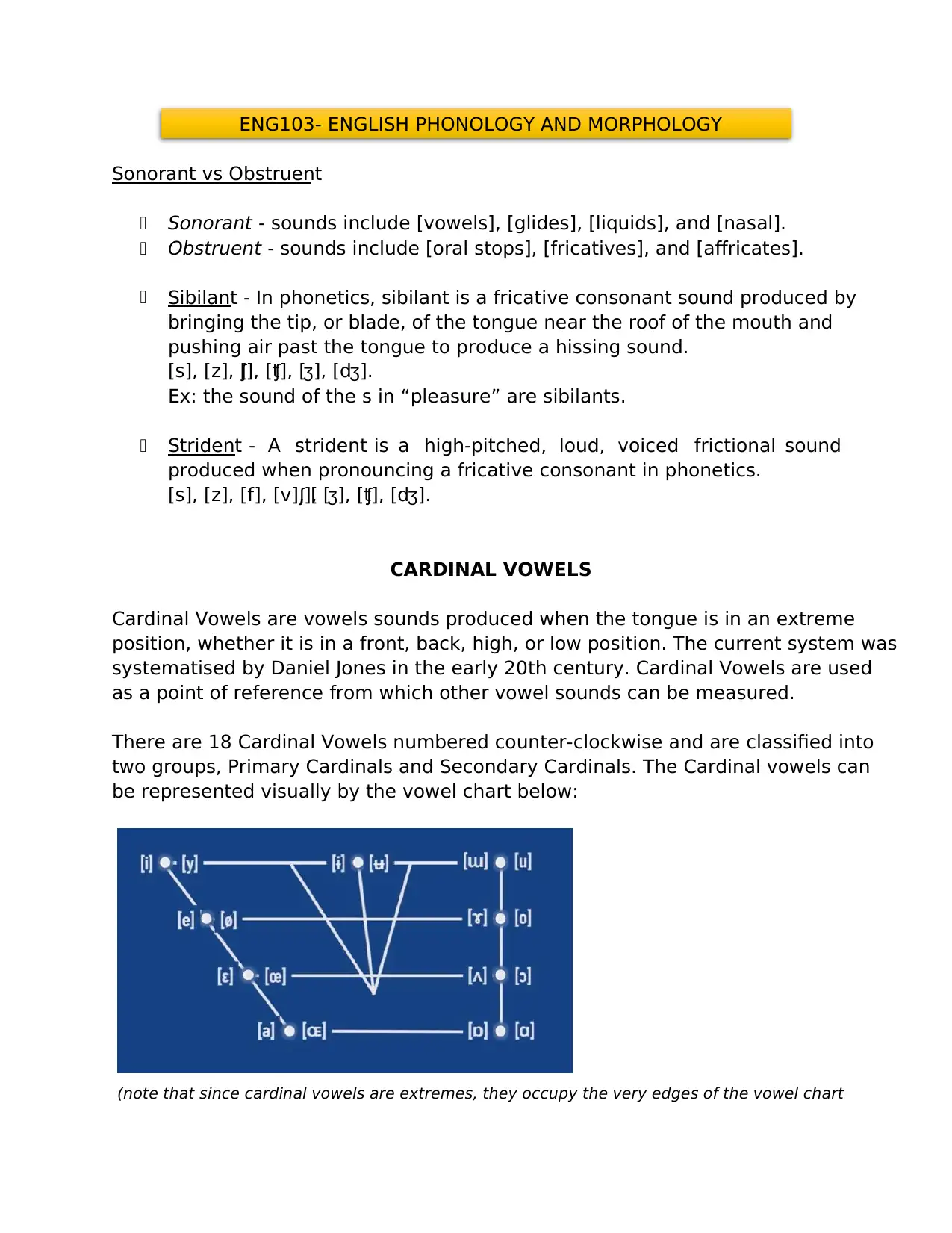
ENG103- ENGLISH PHONOLOGY AND MORPHOLOGY
Sonorant vs Obstruent
Sonorant - sounds include [vowels], [glides], [liquids], and [nasal].
Obstruent - sounds include [oral stops], [fricatives], and [affricates].
Sibilant - In phonetics, sibilant is a fricative consonant sound produced by
bringing the tip, or blade, of the tongue near the roof of the mouth and
pushing air past the tongue to produce a hissing sound.
[s], [z], [ʃ], [tʃ], [ʒ], [dʒ].
Ex: the sound of the s in “pleasure” are sibilants.
Strident - A strident is a high-pitched, loud, voiced frictional sound
produced when pronouncing a fricative consonant in phonetics.
[s], [z], [f], [v], [ʃ], [ʒ], [tʃ], [dʒ].
CARDINAL VOWELS
Cardinal Vowels are vowels sounds produced when the tongue is in an extreme
position, whether it is in a front, back, high, or low position. The current system was
systematised by Daniel Jones in the early 20th century. Cardinal Vowels are used
as a point of reference from which other vowel sounds can be measured.
There are 18 Cardinal Vowels numbered counter-clockwise and are classified into
two groups, Primary Cardinals and Secondary Cardinals. The Cardinal vowels can
be represented visually by the vowel chart below:
(note that since cardinal vowels are extremes, they occupy the very edges of the vowel chart
Sonorant vs Obstruent
Sonorant - sounds include [vowels], [glides], [liquids], and [nasal].
Obstruent - sounds include [oral stops], [fricatives], and [affricates].
Sibilant - In phonetics, sibilant is a fricative consonant sound produced by
bringing the tip, or blade, of the tongue near the roof of the mouth and
pushing air past the tongue to produce a hissing sound.
[s], [z], [ʃ], [tʃ], [ʒ], [dʒ].
Ex: the sound of the s in “pleasure” are sibilants.
Strident - A strident is a high-pitched, loud, voiced frictional sound
produced when pronouncing a fricative consonant in phonetics.
[s], [z], [f], [v], [ʃ], [ʒ], [tʃ], [dʒ].
CARDINAL VOWELS
Cardinal Vowels are vowels sounds produced when the tongue is in an extreme
position, whether it is in a front, back, high, or low position. The current system was
systematised by Daniel Jones in the early 20th century. Cardinal Vowels are used
as a point of reference from which other vowel sounds can be measured.
There are 18 Cardinal Vowels numbered counter-clockwise and are classified into
two groups, Primary Cardinals and Secondary Cardinals. The Cardinal vowels can
be represented visually by the vowel chart below:
(note that since cardinal vowels are extremes, they occupy the very edges of the vowel chart
Paraphrase This Document
Need a fresh take? Get an instant paraphrase of this document with our AI Paraphraser
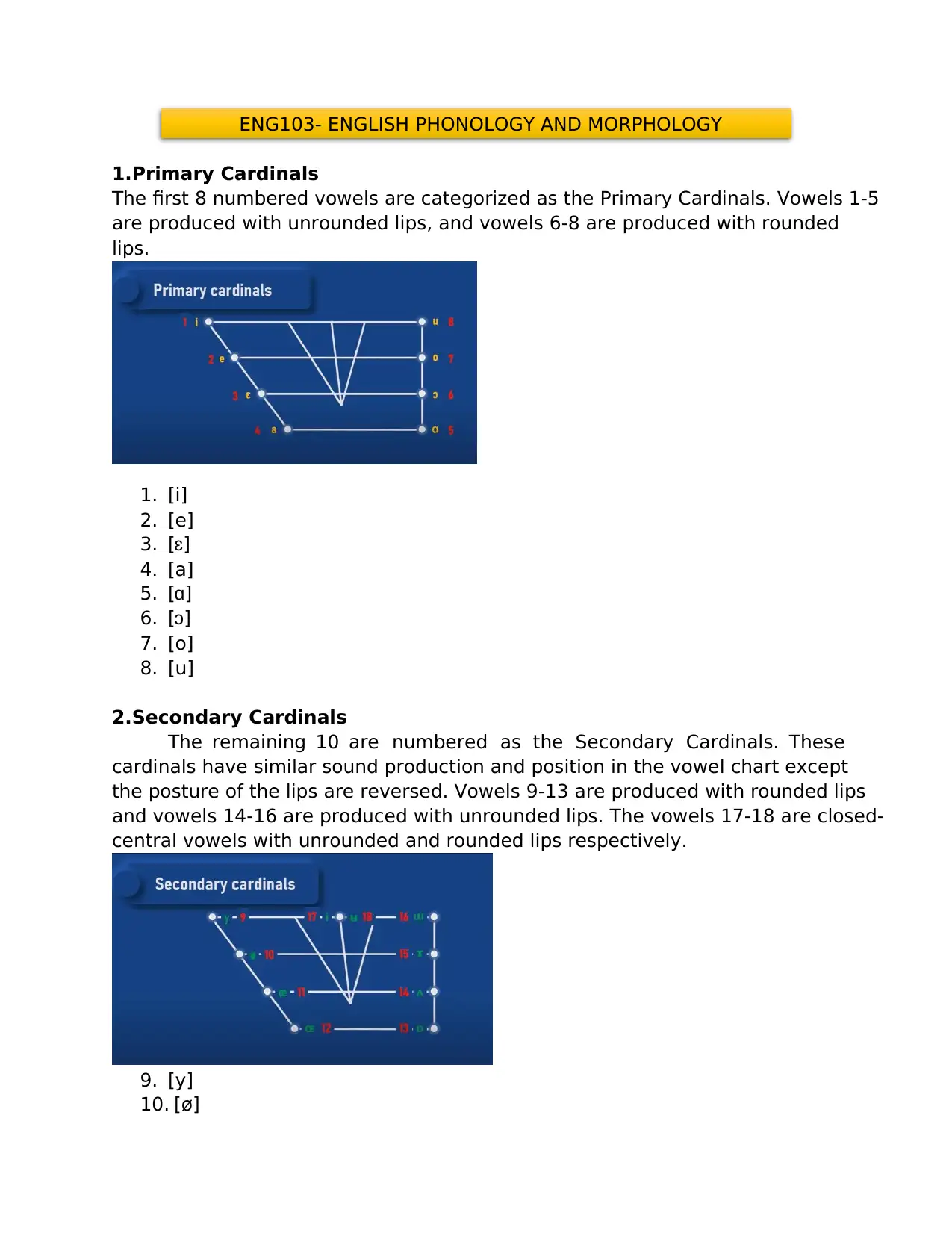
ENG103- ENGLISH PHONOLOGY AND MORPHOLOGY
1.Primary Cardinals
The first 8 numbered vowels are categorized as the Primary Cardinals. Vowels 1-5
are produced with unrounded lips, and vowels 6-8 are produced with rounded
lips.
1. [i]
2. [e]
3. [ɛ]
4. [a]
5. [ɑ]
6. [ɔ]
7. [o]
8. [u]
2.Secondary Cardinals
The remaining 10 are numbered as the Secondary Cardinals. These
cardinals have similar sound production and position in the vowel chart except
the posture of the lips are reversed. Vowels 9-13 are produced with rounded lips
and vowels 14-16 are produced with unrounded lips. The vowels 17-18 are closed-
central vowels with unrounded and rounded lips respectively.
9. [y]
10. [ø]
1.Primary Cardinals
The first 8 numbered vowels are categorized as the Primary Cardinals. Vowels 1-5
are produced with unrounded lips, and vowels 6-8 are produced with rounded
lips.
1. [i]
2. [e]
3. [ɛ]
4. [a]
5. [ɑ]
6. [ɔ]
7. [o]
8. [u]
2.Secondary Cardinals
The remaining 10 are numbered as the Secondary Cardinals. These
cardinals have similar sound production and position in the vowel chart except
the posture of the lips are reversed. Vowels 9-13 are produced with rounded lips
and vowels 14-16 are produced with unrounded lips. The vowels 17-18 are closed-
central vowels with unrounded and rounded lips respectively.
9. [y]
10. [ø]
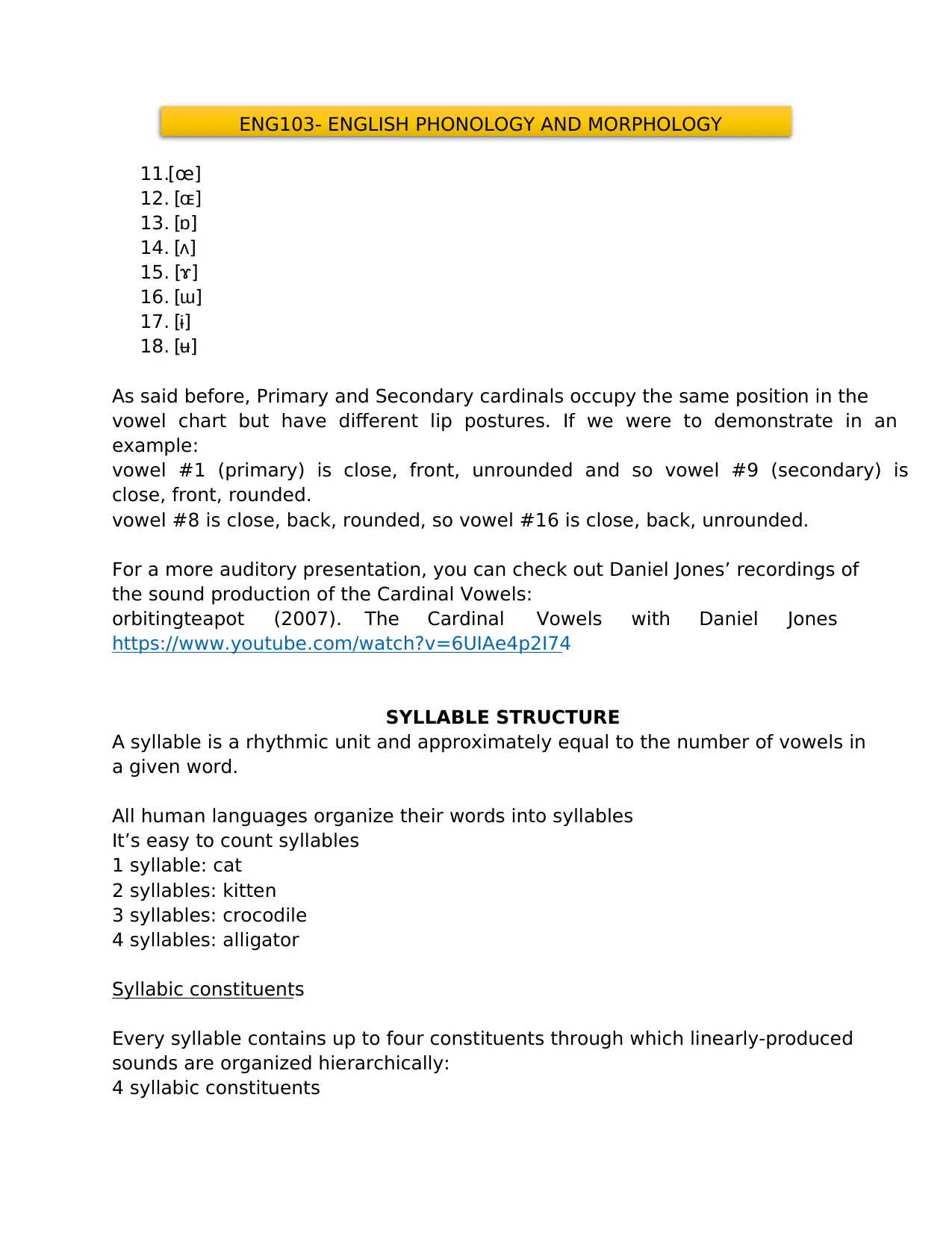
ENG103- ENGLISH PHONOLOGY AND MORPHOLOGY
11.[œ]
12. [ɶ]
13. [ɒ]
14. [ʌ]
15. [ɤ]
16. [ɯ]
17. [ɨ]
18. [ʉ]
As said before, Primary and Secondary cardinals occupy the same position in the
vowel chart but have different lip postures. If we were to demonstrate in an
example:
vowel #1 (primary) is close, front, unrounded and so vowel #9 (secondary) is
close, front, rounded.
vowel #8 is close, back, rounded, so vowel #16 is close, back, unrounded.
For a more auditory presentation, you can check out Daniel Jones’ recordings of
the sound production of the Cardinal Vowels:
orbitingteapot (2007). The Cardinal Vowels with Daniel Jones
https://www.youtube.com/watch?v=6UIAe4p2I74
SYLLABLE STRUCTURE
A syllable is a rhythmic unit and approximately equal to the number of vowels in
a given word.
All human languages organize their words into syllables
It’s easy to count syllables
1 syllable: cat
2 syllables: kitten
3 syllables: crocodile
4 syllables: alligator
Syllabic constituents
Every syllable contains up to four constituents through which linearly-produced
sounds are organized hierarchically:
4 syllabic constituents
11.[œ]
12. [ɶ]
13. [ɒ]
14. [ʌ]
15. [ɤ]
16. [ɯ]
17. [ɨ]
18. [ʉ]
As said before, Primary and Secondary cardinals occupy the same position in the
vowel chart but have different lip postures. If we were to demonstrate in an
example:
vowel #1 (primary) is close, front, unrounded and so vowel #9 (secondary) is
close, front, rounded.
vowel #8 is close, back, rounded, so vowel #16 is close, back, unrounded.
For a more auditory presentation, you can check out Daniel Jones’ recordings of
the sound production of the Cardinal Vowels:
orbitingteapot (2007). The Cardinal Vowels with Daniel Jones
https://www.youtube.com/watch?v=6UIAe4p2I74
SYLLABLE STRUCTURE
A syllable is a rhythmic unit and approximately equal to the number of vowels in
a given word.
All human languages organize their words into syllables
It’s easy to count syllables
1 syllable: cat
2 syllables: kitten
3 syllables: crocodile
4 syllables: alligator
Syllabic constituents
Every syllable contains up to four constituents through which linearly-produced
sounds are organized hierarchically:
4 syllabic constituents
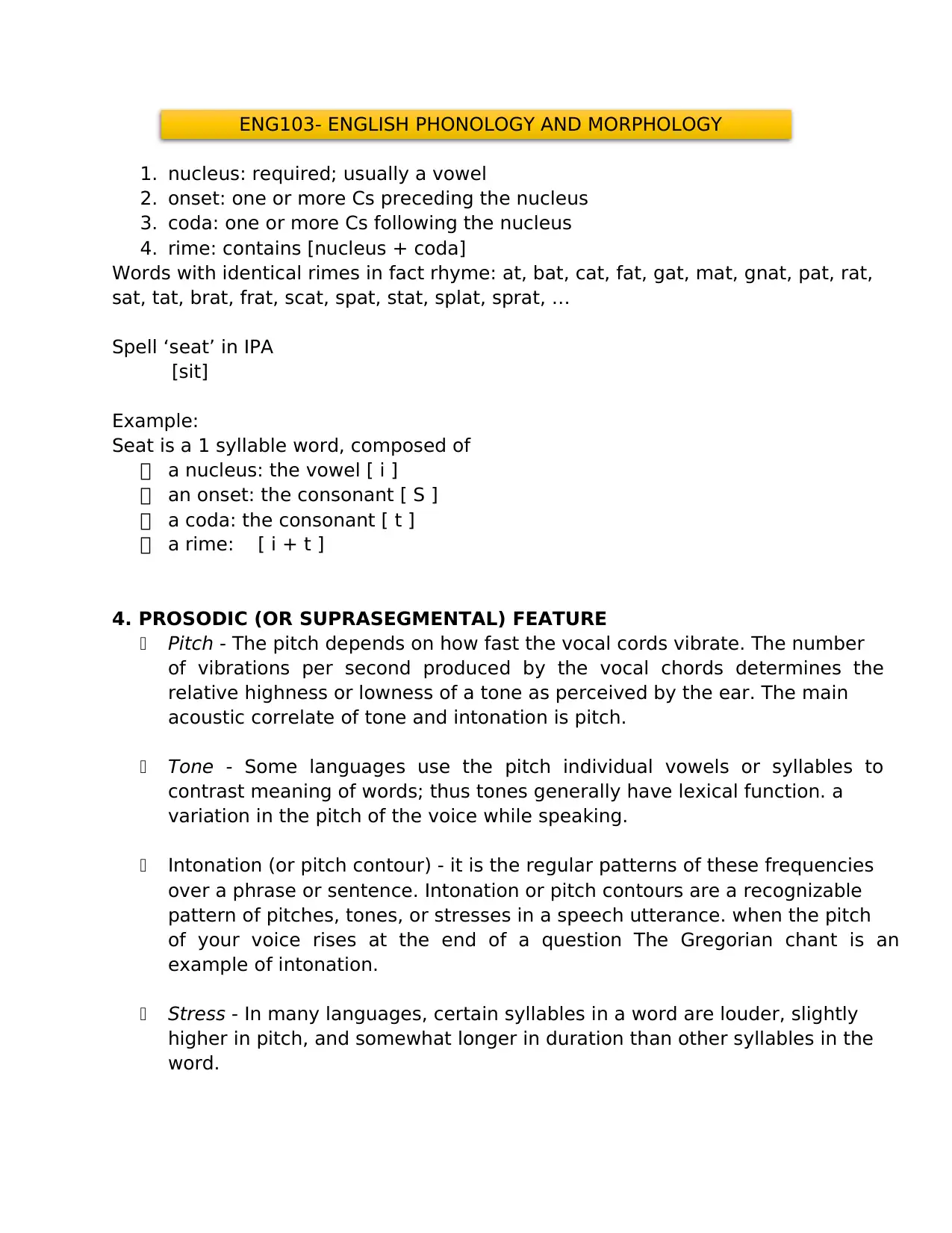
ENG103- ENGLISH PHONOLOGY AND MORPHOLOGY
1. nucleus: required; usually a vowel
2. onset: one or more Cs preceding the nucleus
3. coda: one or more Cs following the nucleus
4. rime: contains [nucleus + coda]
Words with identical rimes in fact rhyme: at, bat, cat, fat, gat, mat, gnat, pat, rat,
sat, tat, brat, frat, scat, spat, stat, splat, sprat, …
Spell ‘seat’ in IPA
[sit]
Example:
Seat is a 1 syllable word, composed of
a nucleus: the vowel [ i ]
an onset: the consonant [ S ]
a coda: the consonant [ t ]
a rime: [ i + t ]
4. PROSODIC (OR SUPRASEGMENTAL) FEATURE
Pitch - The pitch depends on how fast the vocal cords vibrate. The number
of vibrations per second produced by the vocal chords determines the
relative highness or lowness of a tone as perceived by the ear. The main
acoustic correlate of tone and intonation is pitch.
Tone - Some languages use the pitch individual vowels or syllables to
contrast meaning of words; thus tones generally have lexical function. a
variation in the pitch of the voice while speaking.
Intonation (or pitch contour) - it is the regular patterns of these frequencies
over a phrase or sentence. Intonation or pitch contours are a recognizable
pattern of pitches, tones, or stresses in a speech utterance. when the pitch
of your voice rises at the end of a question The Gregorian chant is an
example of intonation.
Stress - In many languages, certain syllables in a word are louder, slightly
higher in pitch, and somewhat longer in duration than other syllables in the
word.
1. nucleus: required; usually a vowel
2. onset: one or more Cs preceding the nucleus
3. coda: one or more Cs following the nucleus
4. rime: contains [nucleus + coda]
Words with identical rimes in fact rhyme: at, bat, cat, fat, gat, mat, gnat, pat, rat,
sat, tat, brat, frat, scat, spat, stat, splat, sprat, …
Spell ‘seat’ in IPA
[sit]
Example:
Seat is a 1 syllable word, composed of
a nucleus: the vowel [ i ]
an onset: the consonant [ S ]
a coda: the consonant [ t ]
a rime: [ i + t ]
4. PROSODIC (OR SUPRASEGMENTAL) FEATURE
Pitch - The pitch depends on how fast the vocal cords vibrate. The number
of vibrations per second produced by the vocal chords determines the
relative highness or lowness of a tone as perceived by the ear. The main
acoustic correlate of tone and intonation is pitch.
Tone - Some languages use the pitch individual vowels or syllables to
contrast meaning of words; thus tones generally have lexical function. a
variation in the pitch of the voice while speaking.
Intonation (or pitch contour) - it is the regular patterns of these frequencies
over a phrase or sentence. Intonation or pitch contours are a recognizable
pattern of pitches, tones, or stresses in a speech utterance. when the pitch
of your voice rises at the end of a question The Gregorian chant is an
example of intonation.
Stress - In many languages, certain syllables in a word are louder, slightly
higher in pitch, and somewhat longer in duration than other syllables in the
word.
Secure Best Marks with AI Grader
Need help grading? Try our AI Grader for instant feedback on your assignments.
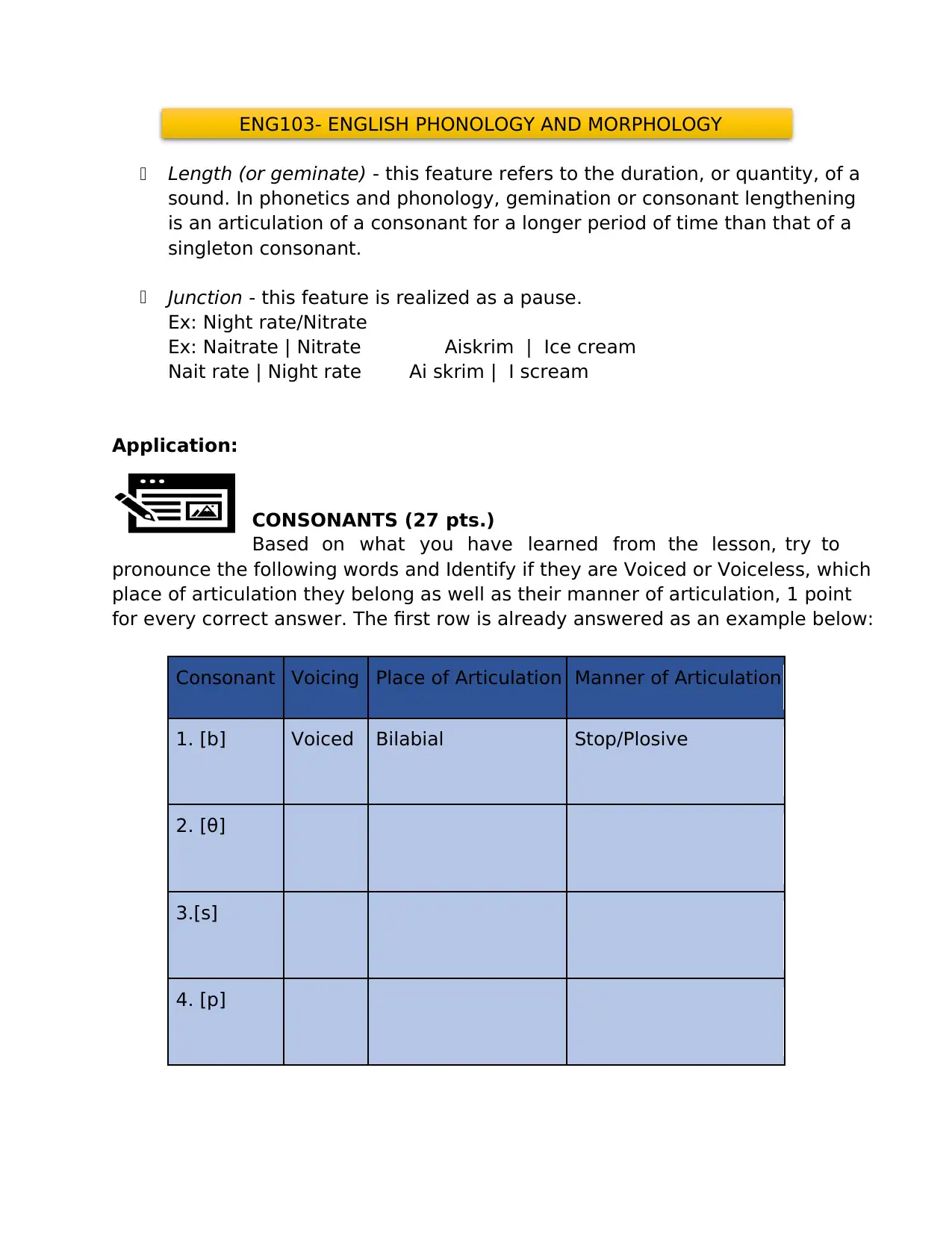
ENG103- ENGLISH PHONOLOGY AND MORPHOLOGY
Length (or geminate) - this feature refers to the duration, or quantity, of a
sound. In phonetics and phonology, gemination or consonant lengthening
is an articulation of a consonant for a longer period of time than that of a
singleton consonant.
Junction - this feature is realized as a pause.
Ex: Night rate/Nitrate
Ex: Naitrate | Nitrate Aiskrim | Ice cream
Nait rate | Night rate Ai skrim | I scream
Application:
CONSONANTS (27 pts.)
Based on what you have learned from the lesson, try to
pronounce the following words and Identify if they are Voiced or Voiceless, which
place of articulation they belong as well as their manner of articulation, 1 point
for every correct answer. The first row is already answered as an example below:
Consonant Voicing Place of Articulation Manner of Articulation
1. [b] Voiced Bilabial Stop/Plosive
2. [θ]
3.[s]
4. [p]
Length (or geminate) - this feature refers to the duration, or quantity, of a
sound. In phonetics and phonology, gemination or consonant lengthening
is an articulation of a consonant for a longer period of time than that of a
singleton consonant.
Junction - this feature is realized as a pause.
Ex: Night rate/Nitrate
Ex: Naitrate | Nitrate Aiskrim | Ice cream
Nait rate | Night rate Ai skrim | I scream
Application:
CONSONANTS (27 pts.)
Based on what you have learned from the lesson, try to
pronounce the following words and Identify if they are Voiced or Voiceless, which
place of articulation they belong as well as their manner of articulation, 1 point
for every correct answer. The first row is already answered as an example below:
Consonant Voicing Place of Articulation Manner of Articulation
1. [b] Voiced Bilabial Stop/Plosive
2. [θ]
3.[s]
4. [p]
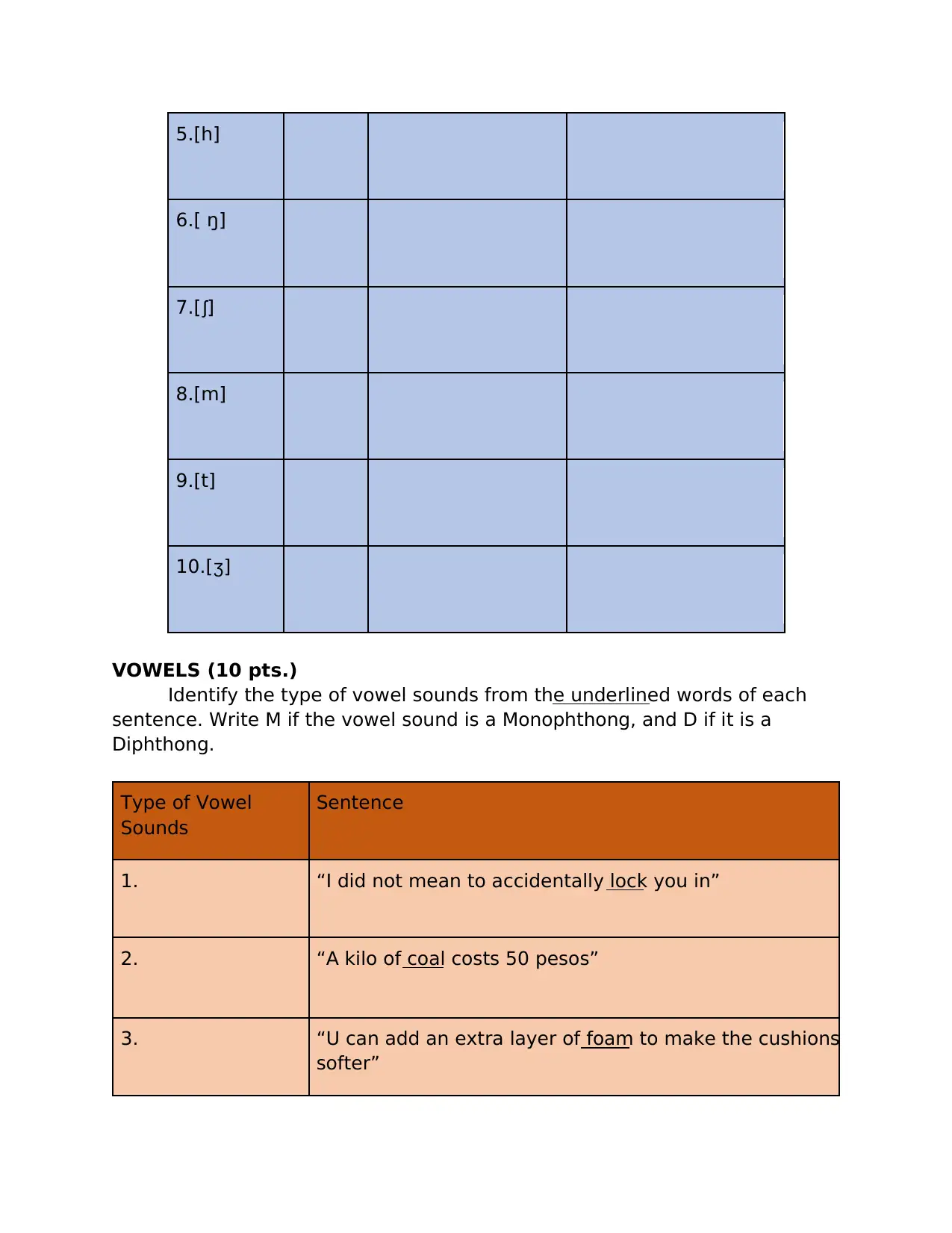
5.[h]
6.[ ŋ]
7.[ ʃ]
8.[m]
9.[t]
10.[ʒ]
VOWELS (10 pts.)
Identify the type of vowel sounds from the underlined words of each
sentence. Write M if the vowel sound is a Monophthong, and D if it is a
Diphthong.
Type of Vowel
Sounds
Sentence
1. “I did not mean to accidentally lock you in”
2. “A kilo of coal costs 50 pesos”
3. “U can add an extra layer of foam to make the cushions
softer”
6.[ ŋ]
7.[ ʃ]
8.[m]
9.[t]
10.[ʒ]
VOWELS (10 pts.)
Identify the type of vowel sounds from the underlined words of each
sentence. Write M if the vowel sound is a Monophthong, and D if it is a
Diphthong.
Type of Vowel
Sounds
Sentence
1. “I did not mean to accidentally lock you in”
2. “A kilo of coal costs 50 pesos”
3. “U can add an extra layer of foam to make the cushions
softer”
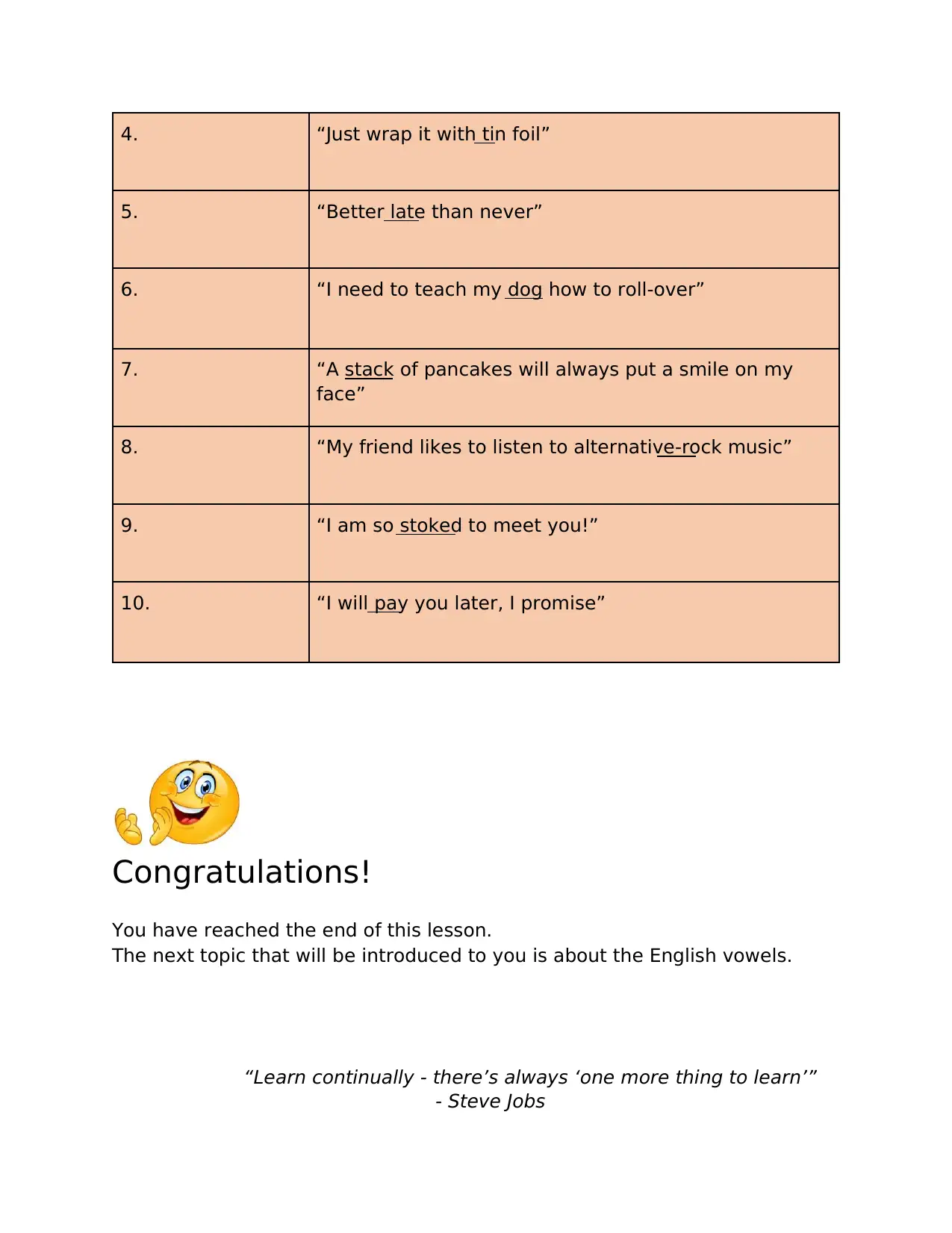
4. “Just wrap it with tin foil”
5. “Better late than never”
6. “I need to teach my dog how to roll-over”
7. “A stack of pancakes will always put a smile on my
face”
8. “My friend likes to listen to alternative-rock music”
9. “I am so stoked to meet you!”
10. “I will pay you later, I promise”
Congratulations!
You have reached the end of this lesson.
The next topic that will be introduced to you is about the English vowels.
“Learn continually - there’s always ‘one more thing to learn’”
- Steve Jobs
5. “Better late than never”
6. “I need to teach my dog how to roll-over”
7. “A stack of pancakes will always put a smile on my
face”
8. “My friend likes to listen to alternative-rock music”
9. “I am so stoked to meet you!”
10. “I will pay you later, I promise”
Congratulations!
You have reached the end of this lesson.
The next topic that will be introduced to you is about the English vowels.
“Learn continually - there’s always ‘one more thing to learn’”
- Steve Jobs
Paraphrase This Document
Need a fresh take? Get an instant paraphrase of this document with our AI Paraphraser
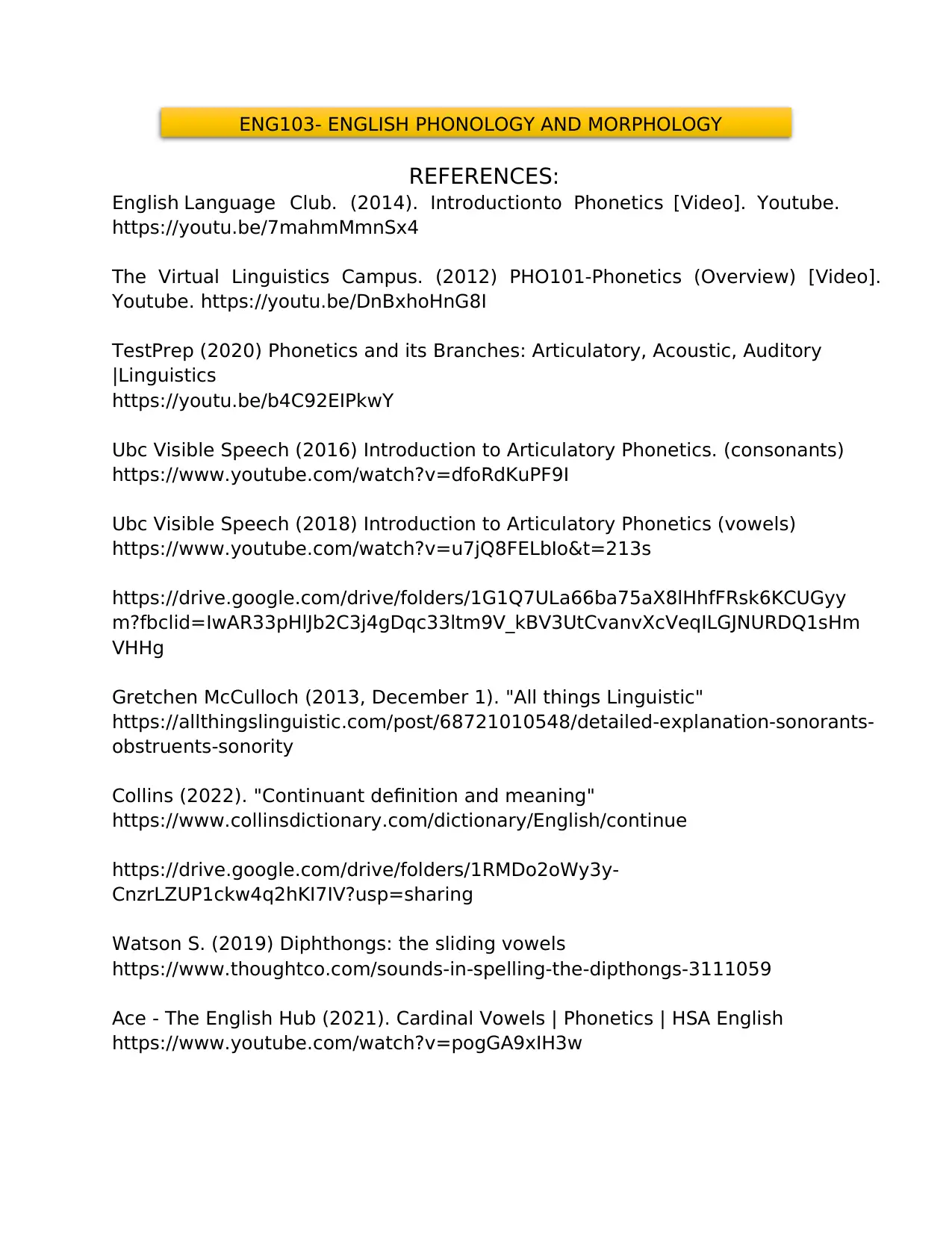
ENG103- ENGLISH PHONOLOGY AND MORPHOLOGY
REFERENCES:
English Language Club. (2014). Introductionto Phonetics [Video]. Youtube.
https://youtu.be/7mahmMmnSx4
The Virtual Linguistics Campus. (2012) PHO101-Phonetics (Overview) [Video].
Youtube. https://youtu.be/DnBxhoHnG8I
TestPrep (2020) Phonetics and its Branches: Articulatory, Acoustic, Auditory
|Linguistics
https://youtu.be/b4C92EIPkwY
Ubc Visible Speech (2016) Introduction to Articulatory Phonetics. (consonants)
https://www.youtube.com/watch?v=dfoRdKuPF9I
Ubc Visible Speech (2018) Introduction to Articulatory Phonetics (vowels)
https://www.youtube.com/watch?v=u7jQ8FELbIo&t=213s
https://drive.google.com/drive/folders/1G1Q7ULa66ba75aX8lHhfFRsk6KCUGyy
m?fbclid=IwAR33pHlJb2C3j4gDqc33ltm9V_kBV3UtCvanvXcVeqILGJNURDQ1sHm
VHHg
Gretchen McCulloch (2013, December 1). "All things Linguistic"
https://allthingslinguistic.com/post/68721010548/detailed-explanation-sonorants-
obstruents-sonority
Collins (2022). "Continuant definition and meaning"
https://www.collinsdictionary.com/dictionary/English/continue
https://drive.google.com/drive/folders/1RMDo2oWy3y-
CnzrLZUP1ckw4q2hKI7IV?usp=sharing
Watson S. (2019) Diphthongs: the sliding vowels
https://www.thoughtco.com/sounds-in-spelling-the-dipthongs-3111059
Ace - The English Hub (2021). Cardinal Vowels | Phonetics | HSA English
https://www.youtube.com/watch?v=pogGA9xIH3w
REFERENCES:
English Language Club. (2014). Introductionto Phonetics [Video]. Youtube.
https://youtu.be/7mahmMmnSx4
The Virtual Linguistics Campus. (2012) PHO101-Phonetics (Overview) [Video].
Youtube. https://youtu.be/DnBxhoHnG8I
TestPrep (2020) Phonetics and its Branches: Articulatory, Acoustic, Auditory
|Linguistics
https://youtu.be/b4C92EIPkwY
Ubc Visible Speech (2016) Introduction to Articulatory Phonetics. (consonants)
https://www.youtube.com/watch?v=dfoRdKuPF9I
Ubc Visible Speech (2018) Introduction to Articulatory Phonetics (vowels)
https://www.youtube.com/watch?v=u7jQ8FELbIo&t=213s
https://drive.google.com/drive/folders/1G1Q7ULa66ba75aX8lHhfFRsk6KCUGyy
m?fbclid=IwAR33pHlJb2C3j4gDqc33ltm9V_kBV3UtCvanvXcVeqILGJNURDQ1sHm
VHHg
Gretchen McCulloch (2013, December 1). "All things Linguistic"
https://allthingslinguistic.com/post/68721010548/detailed-explanation-sonorants-
obstruents-sonority
Collins (2022). "Continuant definition and meaning"
https://www.collinsdictionary.com/dictionary/English/continue
https://drive.google.com/drive/folders/1RMDo2oWy3y-
CnzrLZUP1ckw4q2hKI7IV?usp=sharing
Watson S. (2019) Diphthongs: the sliding vowels
https://www.thoughtco.com/sounds-in-spelling-the-dipthongs-3111059
Ace - The English Hub (2021). Cardinal Vowels | Phonetics | HSA English
https://www.youtube.com/watch?v=pogGA9xIH3w
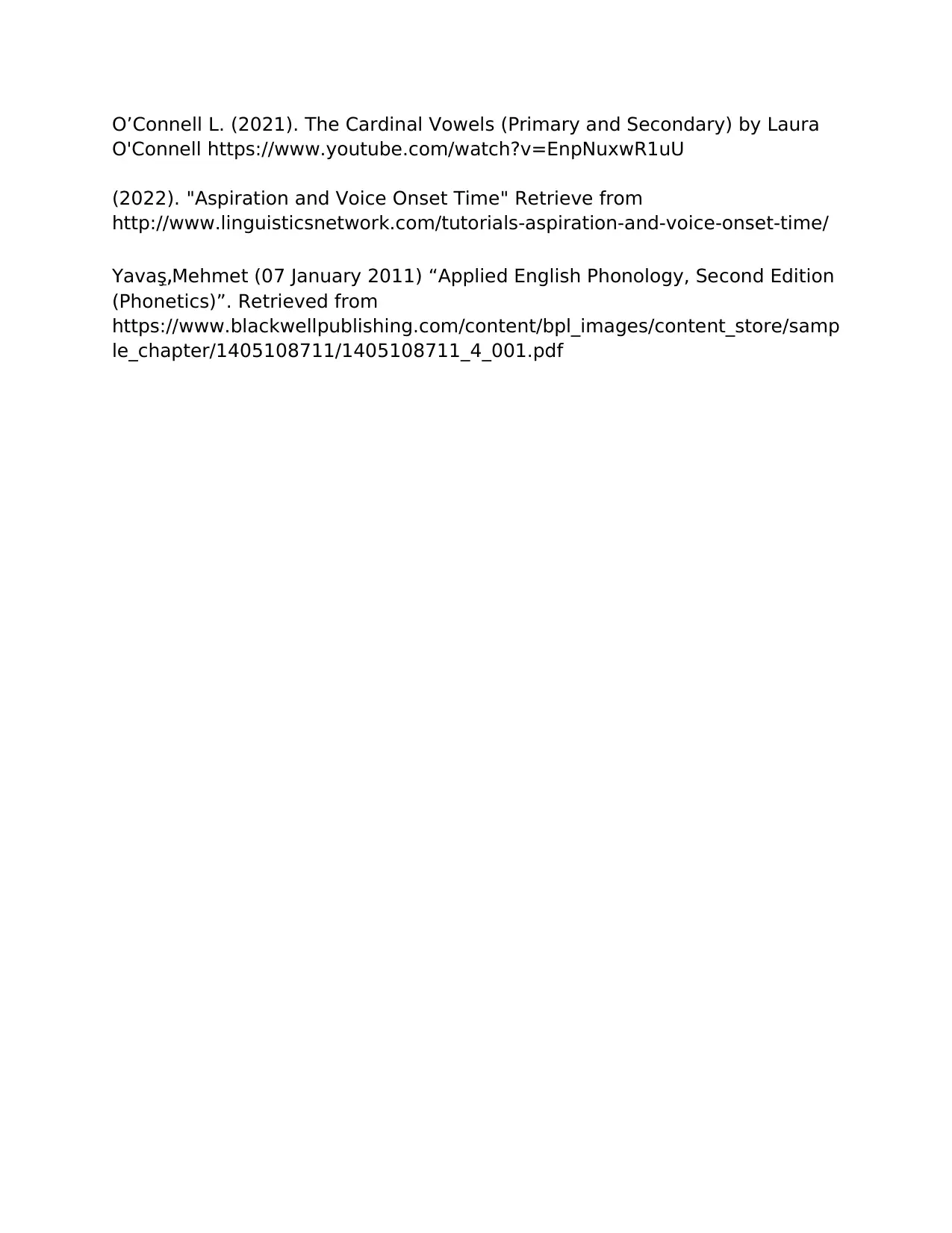
O’Connell L. (2021). The Cardinal Vowels (Primary and Secondary) by Laura
O'Connell https://www.youtube.com/watch?v=EnpNuxwR1uU
(2022). "Aspiration and Voice Onset Time" Retrieve from
http://www.linguisticsnetwork.com/tutorials-aspiration-and-voice-onset-time/
Yavaş,Mehmet (07 January 2011) “Applied English Phonology, Second Edition
(Phonetics)”. Retrieved from
https://www.blackwellpublishing.com/content/bpl_images/content_store/samp
le_chapter/1405108711/1405108711_4_001.pdf
O'Connell https://www.youtube.com/watch?v=EnpNuxwR1uU
(2022). "Aspiration and Voice Onset Time" Retrieve from
http://www.linguisticsnetwork.com/tutorials-aspiration-and-voice-onset-time/
Yavaş,Mehmet (07 January 2011) “Applied English Phonology, Second Edition
(Phonetics)”. Retrieved from
https://www.blackwellpublishing.com/content/bpl_images/content_store/samp
le_chapter/1405108711/1405108711_4_001.pdf
1 out of 27
Your All-in-One AI-Powered Toolkit for Academic Success.
+13062052269
info@desklib.com
Available 24*7 on WhatsApp / Email
![[object Object]](/_next/static/media/star-bottom.7253800d.svg)
Unlock your academic potential
© 2024 | Zucol Services PVT LTD | All rights reserved.